Many thanks to:
Hek, LA Rationalists, LA EA organizers, and various TPOTs I have ran into these past few months who have listened to me get on my soapbox and engage in hours of dialogue about my biggest passion - community. This one’s for y’all.
Summary
Through the past ten years, I have dedicated my life’s work to building, managing, and scaling communities. Today, I will share my collective learnings through my proposal of how communities should be structured to form healthy, thriving, and growing organizations across the globe. I have created two models, the Community Action Model (CAM) and the Community Consumption Model (CCM). They boil down to the four Community Actions - Create, Sustain, Rejuvenate, and Innovate - and the four Community Consumptions - Lurk, Engage, Learn, Participate. These actions and consumptions that should be at the root of any community that has yet to be created, in the middle of significant change, or looking to improve for the betterment of sustainability and high-achieving goals any organization has.
After I have detailed my community philosophy, I dive into an assessment of where the EA community is currently at, what it’s achieved, and how it is stunted in growth from an external perspective. The first application of the CAM + CCM are crossed over with EA-defined community building models that are shared amongst the organizers and CEA. It is proven that their models are disjointed and unable to foster the proper foundation that is needed to build a big-tent movement. Additionally, I apply them to EA on a macro scale to prove that EA is an ineffective, non-operational, and unsustainable movement and community. The current state of EA is a consequence of non-cohesive community planning with afterthoughts left across the movement that were never wrapped up and wreaked havoc on the community's potential.
In the following passages of my thesis, it is focused upon how to uplift and revitalize the existing EA community. Through the programs and structures that I will outline, it will build the proper foundation for EA to expand regardless of if they choose to challenge their existing and core philosophical undertakings. None of the proposals to change granular-level EA conquests will be ever be achieved until EA's fundamental core changes. All the wide areas of criticism and suggestions will continue to run into the same issues as the community continues to churn into nothing. EA has the potential to become a robust and sustainable movement, but without caution and strategy, they will not be together to actualize longtermist goals.
Finally, I will notate my personal opinions of what needs to change about the culture, philosophy, and community philosophy of EA to create an even more effective and cohesive community. The following passages will notate my suggestions, criticisms, and action items to resolve some glaring issues that I have picked up since joining the community. Read along if you are seeking a brighter future for social change and creating sustainable communities at any scale.
Section 1 - Introduction
1.1 What is a community?
What used to define local neighborhoods is now a term that has permeated all facets of our lives. Communities can now mean a subreddit like Wall Street Bets, a purse forum detailing luxury purchases, or a revolving enrollment of a kickball league for intramural sports. No longer can community only be defined only through physical means but through the actions and consumption one must go through to live through the community experience.
My definition? A community is a group of people that share values, experiences, and currency.
Values that detail the social norms, rituals, and goals that a community puts together to keep virtuous peace.
Experiences that highlight the events, programs, and one-off occasions that create a bond between the member and their surroundings.
Currency as the social technology that weaves and knits the interpersonal relationships to make a community function as whole.
To distill it down to this definition is to realize that we must refine and give nuance where each category lies in building the parameters of community infrastructure. Starting with values, they can now be applied in more than just socio-economic, political or religious starting points and can be crafted based off the environment the community was built and continues to live in. Experiences can now live on the internet, in-person, or somewhere in between as we enter a new chapter of hybrid style work, recreation, and lifestyle. And last, currency is what often is custom-created by each community as the intangible social reward scoring system that they all consent to, and the most ambitious members accrue the proper capital to gain influence, power and significance towards the organization.
Without these three parameters to enclose a starting base of a community, there will be severe issues in scaling up and creating the proper value needed to gather people together.
1.2 Why do communities fail?
All communities should have the expectation that they will fail. Not from the perspective that they never succeeded, but to build and sustain one is only half the work. Often, the sustainability of a community is the most laborious and unachieved facets of tangible work put into the organization. Too often are communities only seen as by the success of the organizers - through events, communication, and hosting, but a community operates as a whole – and has more than one centralized action that creates an outwards spiral of shared opportunity.
Our interpretation of community is too linear, and we need to shift our ideals of community from organizer-centric to a more holistic approach. To start, organizing isn’t everything. There are many roles into how a community forms and takes shape. Forcing organizers to do everything only detracts from the organization as a whole. Most members of a community think that if they’re not an organizer, therefore they cannot contribute, where instead - we should recognize how different actions can collectively enroll as participation towards group fulfillment.
We also need to rethink, delegate and improve the model of what we consider to be a “successful” community. Most communities don’t know how to measure what are the best ways to improve their structure and growth opportunities, let alone be a phenomenal organizer to exact the change they wish to see. We can enhance a to-be community since many new communities don’t know where to start & create strategies that are imbalanced in power instead of creating proper structure instead of seeking and approaching building community putting it all on oneself. We need to seek and share inspiration to create improved techniques towards building the proper social technology needed to advance organizations for the future.
1.3 Frustrations I’ve had as a Community Manager
Through the years of organizing, I have faced and overcome many challenges when communities reach an inflection point of change. It’s from these significant moments that there have been many friction points that are unavoidable through the plight of being a community organizer.
1.3.1 Centralized Power
In imbalanced communities, there is often too much power in one place making it unable to grow organically, and limits the introduction to new opportunities. When there is centralized power, each degree of separation from its center will crater in engagement because of the levels of hierarchy that are required.
1.3.2 Lack of Reciprocity
If the culture isn’t set to give back to the community, it is easy to create a group of takers from the organizers. This often happens when the organizing team does not consider sustainability and delegating responsibility to various members of an organization.
1.3.3 Churn
People will leave communities no matter what, and from that, there is a need to constantly onboard and cycle in new people. Without a process for preventing community churn, the work of the organizers falls flat and detracts from their fullest potential.
1.3.4 Lurkers
Many people only consume and barely enter the precipice of participation. I believe there are ways that we can create healthier communities that can prohibit and lessen the frequency of lurking.
1.3.5 Burnout
Working as a community organizer is hard work. There are many thoughts, actions, ideas that all need to be collated to make collective decisions that benefit everyone involved. Because of this, there are blind spots and over-exposure that make an organizer susceptible to influence, inconsistency, and
1.3.6 Lack of Growth/Innovation
Many communities never grow and they die. This is because the growth and innovation needed to sustain it was never achieved and implemented. When the community does not prioritize innovation after its growth phase, the community is confirmed to die out without reaping the long-term benefits of putting so much effort to achieve
These friction points serve me now as inspiration to mediate and relieve them before they actualize. Also, lack of these points can act as a signifier of a more sustainable community that have mitigated the risk associated with each fatal blow. Unfortunately, most communities cannot overcome these hurdles, because of lack of community organizing education, tooling, and resources. This results in faltering organization, unruly and toxic community members, and burnt out efforts that may never come back.
Section 2 - How do we change communities for the better?
Communities can be changed for the better by understanding the process it takes to build a community. If this was common knowledge, there would be communities overfilling our social lives, and yet, there seems to be a consistent deficit for quality, action-prioritized, and holistic organizations across the globe.
To me, the community organizers are the true activists, not the ones complaining, theorizing, or writing about change. Without actions and people working together, there is nothing to back up any claims of a potential revolution. Inspiration is there to serve ideology, but it simply is not enough to enact innovation off the words on a sheet.
Agency is what should be taught and internalized throughout any education, but we are socialized to adhere to structure. If we make community comprehension a foundational layer of interpersonal change, we can assign a stronger responsibility and loyalty to contributing towards communities that any individual can discern.
2.1 The Community Action Model (CAM)
The Community Action Model is a model I created out of my experiences, hard work, and dedication that I’ve spent over the years of creating communities for other neighborhoods, startups, and companies. This model is meant to be utilized at any scale of any community - from macro to micro. While I intended for this to represent people within their communities, the model can be applied as contributing actions that any organization upholds.
Initially, I was inspired by this map of community roles that is applicable to a social change ecosystem to center my EA thesis around. I found it during the Black Lives Matter protests in spring of 2020 and shared with my peers that contributing towards social change does not only look like organizing. As I’ve grown my community skills since finding this model over two years ago, I found that I needed to advance and further structure the motivations and effects the different roles have and most importantly, the tangible actions that ultimately make a difference.
This model was born to appreciate, understand, and educate others on all of the work community contributions and efforts take. We admire the work done to build companies but with the breadth and range to enact social change - we must recognize the importance of genuine ambition and tenacity of grassroots community building that it takes to get there.
2.2 The Four Community Actions
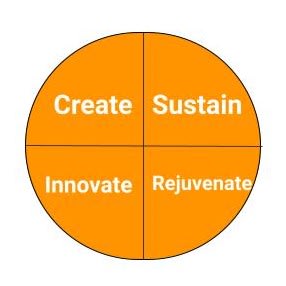
The four community actions are Create, Sustain, Rejuvenate, and Innovate. Together and cyclically respectfully, they create a minimum viable community root - to secure and ground the core of a to-be community. Each action is a category that grows outwards into the incentives, motivations, and participatory roles of each action it starts with. Ideally each community that needs to form has a minimum of one person or targeted task that performs for each category. This helps reduce burnout and balances out the central power of the community as a natural committee - vs. only one person seen as an “organizer/builder”. Later in my thesis I will explain the fixed powers that build when one or more actions are missing and how it affects the communities with severe consequences.
2.2.1 Create
To create for a community, is to build and create something new. Create is based on past agency (actions). They were not satisfied with existing structures/lack of and decided to build a new chapter for a community. The word create is used instead of build because community builders are creators. Building implies the vision and strategy was already there to build upon. Most community organizers don’t have anything to start with - making them the creators from the very beginning.
2.2.2 Sustain
Sustaining, for a community, is to maintain structure and organization. Sustain is based on present structures. They continue the actions of the Creators, and maintain the structure to foster new opportunities. Their operations are often what is the foundation for scaling a community to ambitious goals of membership.
2.2.3 Rejuvenate
To Rejuvenate for a community, is to replenish and refresh all participants. Rejuvenate is based on preventative structure. They do not actively foster and build up structures created by Sustainers, but replenish and refuel the community. They are the ones that perform actions that often don’t scale - but are necessary to maintain inner-organization homeostasis.
2.2.4 Innovate
To Innovate for a community, is to explore and disrupt for future conquest. Innovate is based on future agency (actions). They seek bigger and better ideas and opportunities that don’t exist in the existing community and pursue them and share with the existing community. They have the most influence in where the community grows or stagnates for its long-term sustainability.
2.3 Giddens Structuration Theory
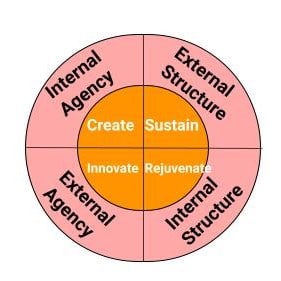
Often there is the chicken and the egg problem with starting a community. At what point are the actions created and captured and significant enough that are worth formulating structure around. Because of this, I have adapted Giddens’ Structuration theory into my model. He claims that an individual’s autonomy is influenced by structure, and structures are maintained and adapted through the exercise of agency. Through this theory, we can understand that in the four community actions, there needs to be balance between the cycle actions towards community consensus. On the left side of the wheel, it is based on agency (actions) to move things forward, and the right side of the wheel shows the structure needed to sustain the actions for further growth.
Additionally, I have added a layer of internal and external factors to further examine the demographics of members in a community that each action person would be facing and impacting through the four community actions. Through “Create”, the action person would be creating for the organization and anything internal to the organization. Through “Sustain”, the action person would be sustaining for the organization and working with external factors or people that are interested in taking part in the community. Through “Rejuvenate”, the action person would be rejuvenating the existing community internally and would not be front-facing. Through “Innovate”, the action person would be innovating for external actions toward the organization.
2.4 Past, Present, Prevent, Future
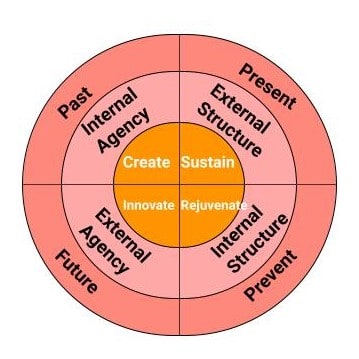
I have added to my model the moment in time in which these actions serve their purpose. The theory behind assigning each action where they fit on a timeline and how they can be affected by intentions and motivations. Creators are getting into action because of Past Actions that did not previously exist. Sustainers are getting into action to give Present Structure that lives for the day-to-day. Rejuvenators are the ones that Prevent Structure which is often referred to as “do things that don’t scale” in start-ups. And Innovate is for Future Actions that have not been achieved yet by the community.
2.5 Community Action Model - Roles
Expanding on the model, I have created roles that are identifiable across any healthy community that contribute to the four central actions. Ideally, there is at least one person, program, or driving force whose tangible actions towards the community are displayed through these archetypes - however, most people will absorb a blend of roles that they take when contributing towards community good. This can be subjective based on a person’s position in the community, however the model stands of implementing this across an organization to improve the ways in which it functions.
Additionally, the further division of roles is to specify what the consequences are of each action. This specificity can illuminate new opportunities that community organizers may not have previously considered in taking on in shared community work.
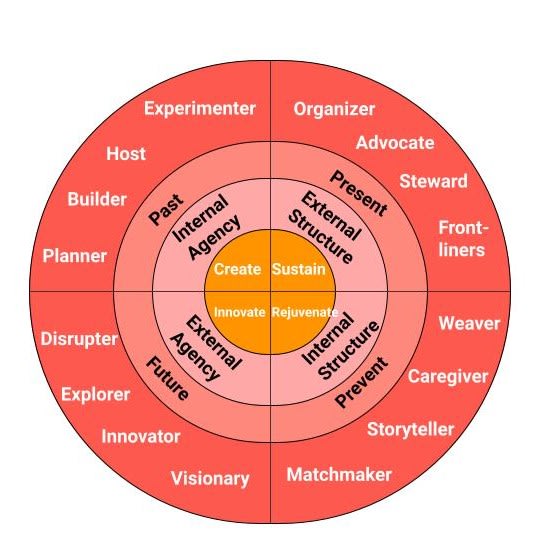
In each community, one can take on different roles and thrive in them - depending on the engagement level that the person commits to in each environment. While one person may be a Rejuvenating-Weaver in their knitting community, may be a Creating-Host in their book club they host each week. One of the most important points to keep in mind is what role do you play for yourself when you build your own family, network, and community?
2.5.1 Create
Host : A host is someone that is a central point of contact during a community experience
Planner : A planner is someone that sets goals, events, and strategy for the community
Builder : A builder is someone that takes responsibility in pursuing and building upon new ideas and suggestions
Experimenter : An experimenter is someone that tries a variety of new ideas without a plan
2.5.2 Sustain
Organizer : An organizer is someone that puts together resources & people necessary to put forth new experiences
Advocate : An advocate is someone that shares externally the benefits and opportunities that lie within the community
Steward : A steward is someone that is a guide that moves things forward through managing existing structure
Front-liners : A front-liner is someone that works with external-facing activities to broker interactions & needs internally
2.5.3 Rejuvenate
Weaver : A weaver is someone that is able to bring people together internally and blend the personalities in a 1:many format
Matchmaker : A matchmaker is someone that creates and fosters 1:1 connections to deepen intimacy amongst community
Care-giver : A caregiver is someone that nourishes and nurtures community members at different points of their journey in the organization
Storyteller : A storyteller is someone that has shares and tells the wisdom, history, and values of the group
2.5.4 Innovate
Disruptor : A disruptor is someone that takes risks to create sudden change and disrupt the community’s existing status quo and rituals
Explorer : An explorer is someone that navigates new opportunities external to the community to branch the organization into new and never tried methods
Innovator : An innovator is someone that harvests and crafts new ideas from external sources to build within the organization
Visionary : A visionary is someone that believes in the community’s future state & creates the strategy to achieve its fullest potential
2.6 The Community Consumption Model (CCM)
Only 10% of any given community are the action-driven contributors. 90% are the consumers that benefit from a strongly organized group. Because of this, consumers must be labeled in where they are at in their journey into a community and how they are directly linked to the outwards actions that were established in the Community Action Model.
The Community Consumption Model is to understand that every single person is a consumer - and we must understand the process in which each phase of consumption community-building is dependent on to graduate from Lurking to full Participation. This model was inspired by solving the eternal September problem.
2.7 The Four Consumption Actions
The Community Action Model is for the contributors of the organization to make a great enough impact to attract and fully engage the consumers. The consumers cannot exist without the creators - and will follow shortly after the actions are put in motion. By understanding the community consuming journey, there is opportunity to expand what is needed from the everyday actions to attract the correct proportion of consumers for an organization’s goals.
The four consumption actions are Lurk, Engage, Learn, and Participate - following in opposite order to how the Community Action Model is formatted.
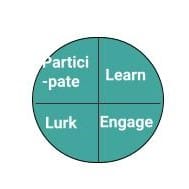
2.7.1 Lurk
To Lurk in a community is to have the minimum participation possible to be considered part of a community. Lurk is based on a future external agency. The lurker is updated with the community’s actions but is not willing to engage beyond themselves being (barely) informed.
2.7.2 Engage
To Engage in a community is to overcome the first barrier to entry into a community. Engage is based on preventative structure. This is penetrated through low-tiered participation where the community consumer is able to navigate potential opportunities if they continue to up their participation.
2.7.3 Learn
To Learn in a community is to educate oneself on the history, social norms, values, experiences, and currency a community utilizes to carry forth its structure. To learn is based on present structure. Learning a community is the step where a consumer decides whether they have what it takes and willing to adhere to the community’s established values, experiences and currency.
2.7.4 Participate
To Participate in a community is to fully engage in various opportunities and openings that are currently available in the organization. Participate is based on past agency. Ideally, all community consumers graduate to the full Participation to be a productive consumer of the organization.
2.7.5 Giddens Structuration Theory
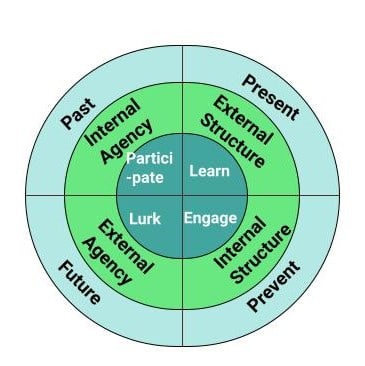
The model continues to follow Giddens Structuration theory and is based on the same agency and structure axis as the CAM. It also follows the timeline pattern matching as the CAM.
2.8 Community Consumption Model - Roles
Because the consumption is attached to the four community actions, the roles are defined as the consequences of the original archetypes and roles of community actions. The consumption roles cannot exist without the action roles and must be defined through that lens.
Most people believe that only the CAM is what community building is, however the true mastery of community management is being able to identify where their community members are at in their consumption journey. They can only then delegate forward which path community consumers should navigate within the community and even graduate past Participation to becoming a contributing action in the CAM.
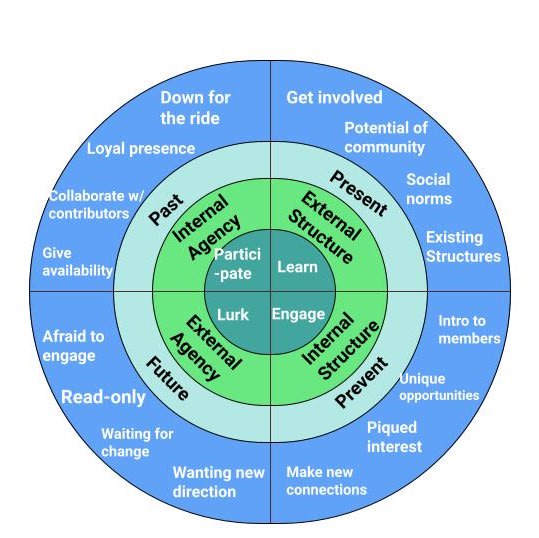
2.8.1 Innovate <> Lurk
Through the Innovators, the direct correlating consumption action is to Lurk. This is dual purpose - many organizers find Lurkers to be problematic and anti-community, however, they are always an indicator of potential change that can happen within the organization. There are the Lurkers that are either afraid to engage or have no interest in engaging because their Lurking capabilities satisfy their need for the community they are a part of. Alternatively, there are Lurkers who are waiting for their vision or true innovation to happen before they choose to engage. The difference between a junior community builder and a seasoned one is segmenting and utilizing different tactics to achieve a lesser pool of disengaged Lurkers, and motivating the Lurkers that have the desire to eventually engage.
Innovator → waiting for change
Explorer → read-only
Disruptor → afraid to engage
Visionary → wanting new direction/ideas
2.8.2 Rejuvenate <> Engage
Often times, when a Lurker graduates to Engagement, they are finding the lowest barrier of entry to permeate a community. For most, speaking directly to organizers is a high bar for the first level of engagement because it would imply further participation needed. Community consumers need more time and agency to decide if the community is worth their fullest participation - and it is easiest to feel out their role and landing in a community when dealing with the inner core of easy-to-approach individuals - the Rejuvenators.
Storyteller → engage any piqued interest + curiosity
Matchmaker → engage in making new connections
Weaver → an intro into the community members
Caregiver → engages + identifies new opportunities unique to individual
2.8.3 Sustain <> Learn
Once the ease has been set to further consume in the community, this is where the external structure has been created to educate the community consumer on their journey into Participation. The structure that external people face to be able to Learn must be rock solid in order for people to identify which type of full Participation they can graduate into. This can be a make-or-break-it moment for community consumers before they give their all to Participate.
Front-liners → educate on existing structures
Steward → educate the social values, experiences, currency & norms
Advocate → educate on the potential of the community
Organizer → educate on how to get involved
2.8.4 Create <> Participate
The Creators are the ones that interact most with the loyal and present Participants. The relationship between the two are at the core of any community and are the highest achieved participation possible. The Creators want to work with the fully engaged Participants because they are able to work and navigate at the same pace instead of the people the Lurkers that have never previously engaged, Engagers that are barely buying in, and the Learners that haven’t quite adjusted and adapted to the community yet.
Planner → creates for the participants that give availability
Builder → creates to collaborate with contributors
Host → creates experiences for a loyal presence
Experimenter → creates for the participants down for the ride
2.9 Graduate vs. Detract
Ideally, community consumers graduate each stage from Lurk to Participate. However, many can relate in their own journeys, without the proper infrastructure of Innovation leading the maturity of the community, community members will step down the ladder of consumption until the community once again matches its need for participation.
This is most seen when a community has lost momentum and traction in moving forward, and loyal Participants either jump right forward into Lurking again, or gradually detract themselves from Learning to Engagement, and then permanent Lurking. The previous Participants turned Lurkers are waiting until their ideal community ro rise up once again since there is stagnation from the lack of Innovation. The CCM really speaks to preparing a better future for the mature community members and how they may go through many cycles of the CCM.
Section 3 - How Communities Form
Each stage of community building is crucial to leveling up to a full CAM + CCM. Ideally each community completes the full 4-step cycle of the models in different growth and expansion phases of the community. Every step for a community to take shape is crucial to understand before you have a completed CAM + CCM
3.1 Innovate + Create
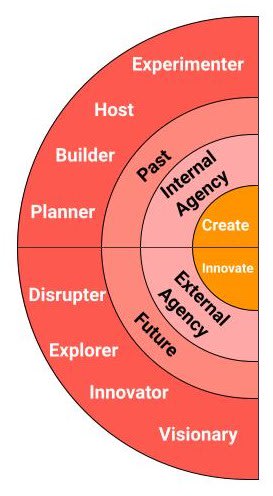
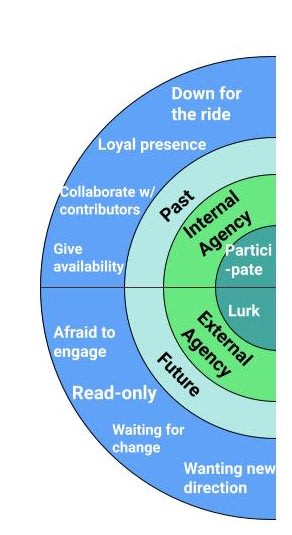
Most communities begin with Innovate and then Create. A stroke of genius in a varietal flavor is what sparks most origins of an organization. Based on the potential of future actions, the discussion of Innovation can begin with what a hypothetical community looks like. After the ideas are explored and set, Creators can begin the process of turning these ideals into tangible function.
3.2 Create + Sustain
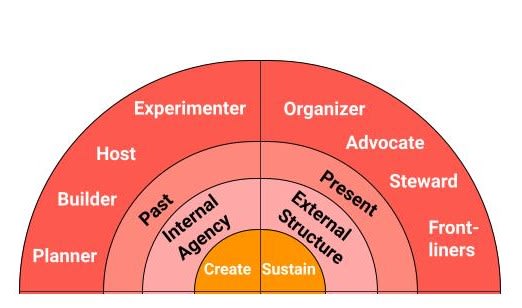
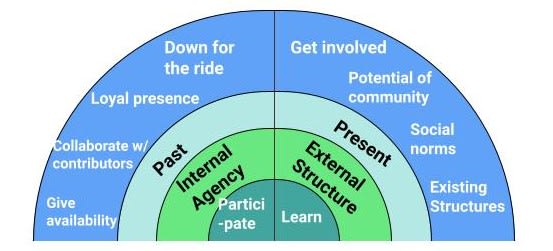
When the Creating phase has commenced, there is the natural need for Sustainability to be able to create further. In this time, Innovation is put on the back burner to reassess what are the direct needs of the organization to begin to grow. The feedback loop is initiated between the two actions of what should be created, tried, and tested before graduating actions and delegating assignments to sustaining habits. Most communities are built like this with the intention to scale through Sustain, but many communities never surpass this phase and never become a whole organization.
3.3 Sustain + Rejuvenate
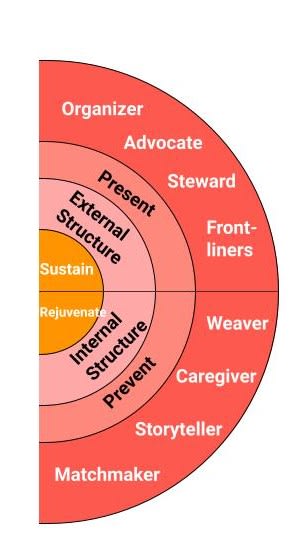
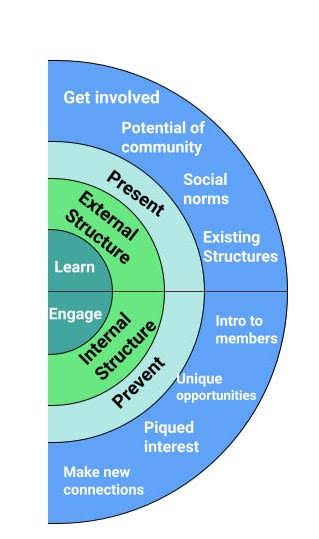
The death of any community is when there are only Sustainers and Rejuvenators left. Ideally, the Creators attract and foster the Rejuvenators in their community to replenish the internal weaving needed to foster connections between all of the members, not just the organizers to the participants. When the existing structure has been set and followed, the Rejuvenators continue to refill the cup of the Sustainers, but it is the ultimate sign of a community that is on the path to being disbanded. Without the opportunity to continually innovate and create, there will not be any new opportunities for the organization to participate in.
3.4 Rejuvenate + Innovate
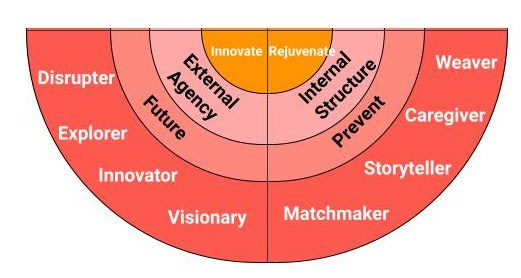
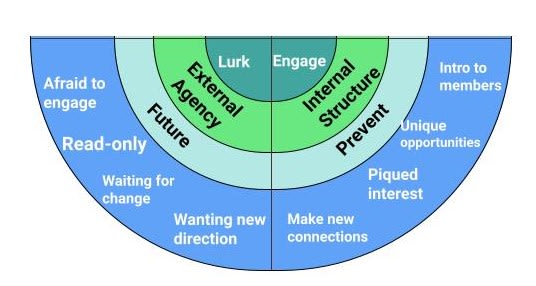
The rarest of combinations is to only find Innovators and Rejuvenators. Oftentimes, it’s rare because the community never takes off or never becomes a whole organization with the lack of Creation and Sustainability. With only Lurking and Engaging for the community consumer, I believe the best way to categorize this phenomena is through parasocial relationships on social media. Most social media “communities” are Visionaries being followed and propped up by the Rejuvenators, Innovators put in the bare minimum level of effort. If people don’t tell the stories, they’re not inspired to start Innovating
3.6 Virtue vs. Morality
Most communities operate under the assumption that in order to contribute towards the community, there needs to be consensus in the values associated with the operations of community building. However building a community is a very different goal than building a moral community or the moral values of a community.
What does this mean? Originally, I was going to name the CAM, the Healthy Community Model, however “healthy” is often too attached to an ideology being agreed upon as a homogenous good,... whatever that “good” may mean. The axis of healthy to toxic communities should apply one’s personal virtues, but the core matter is that community building can be virtuous, but it is ultimately not moral.
This model can be applied to a dichotomy of opposing ideological/moral communities because the actions intended to move forward a community are agnostic to its sustaining existence. We must separate the idea that if a community is “just” and “moral” in its social currency values, it therefore is an effective and sustainable community. Many polarizing communities such as incels, feminists, the U.S. two-party democratic system, etc. display this. These are all movements, communities, and organizations that should additionally be measured on the effectiveness, cohesion, and sustainability of their organization, instead of only their morality, and some “immoral” communities are most absurdly more effective than others.
Community building and actions are by default amoral because of the loyalty and allegiance to the survival of the organization as a whole, not for the individual. Individuality in organization building is antithetical to the purpose of making it larger than oneself. Building a community and taking the initiative to do so should be seen as virtuous, but any moral values of an organization is truly orthogonal to the organization’s operational existence.
3.7 Fixed Power Communities
During certain stages of community building, it can be stuck and has fixed power which detracts the community into a group. What typically happens in many long-term communities is that they move through the CAM and cycle through it various times during its growth phase. When the growth phase ends, typically a quadrant or two disappears as a functioning part of the organization, leaving the community to have severe consequences and imbalance creating the multitude of problems a community can face wreaking havoc of drama, unjust structure, and irreplaceable churn.
The point of identifying and specifying these groups is to assess where the organization is currently at and to move forward to becoming a healthier and flowing community. Each example will list a community that has never grown out of its fixed power and the consequences of staying in such a facet.
3.7.1 Adaptable Groups

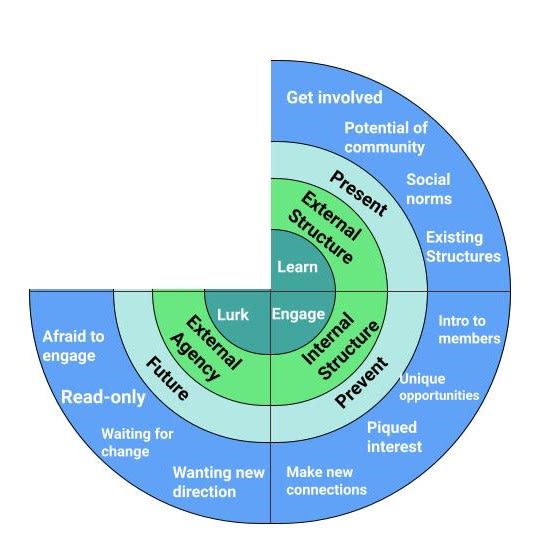
This type of community has all the trappings of what people believe to be healthy communities and what a community should be - except it lies in the theoretical ideology and not in the practical participation. These communities have the Visionaries and Disruptors that display the excitement that the people want to follow, however the structure that has been created prohibits any activity of community consumers beyond low-level Engagement and Learning.
Political parties are a great representation of an Adaptable Group. The ideology, core practices and future endeavors political parties promise are often seen in the Innovate quadrant. Rejuvenate and Sustain are the trickle down effects of the localized groups and sharing the structures of what the party should be - however, many political parties will never give their community consumers the chance to have a full opportunity to Participate.
3.7.2 Unstable Groups
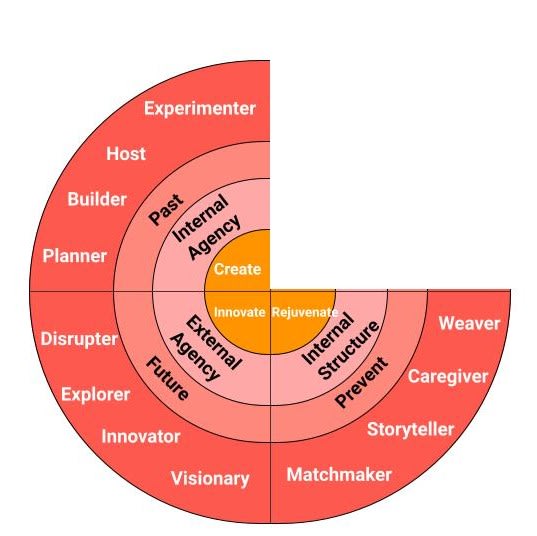
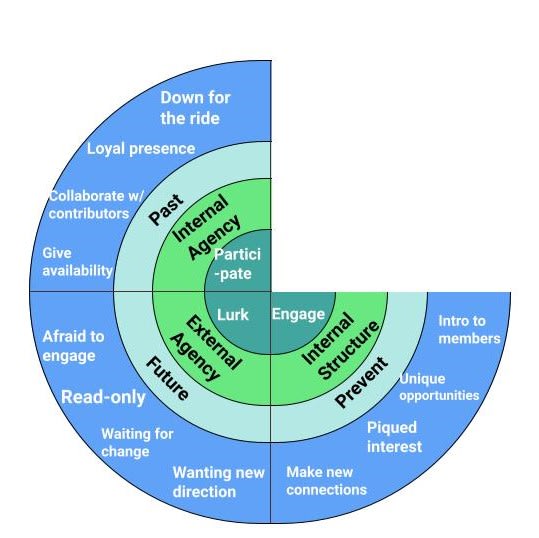
These communities are the ones with the highest amount of churn since there are no sustainable practices embedded into the fabric of the community. They are unstable in the regard that they have no long-term future ahead without any Sustainers that will keep the organization in place. A great example is any university group, club, fraternity etc. There will be, at most, a 4 year cycle of churn through picking up students freshman year that eventually graduate as seniors and restart the community cycle. Of course, there can be succession planning in place, however the group has accepted the fact that with each year that passes, the temporary or complete lack of Sustainers makes the community extremely susceptible to unstable periods of flux.
3.7.3 Toxic Groups
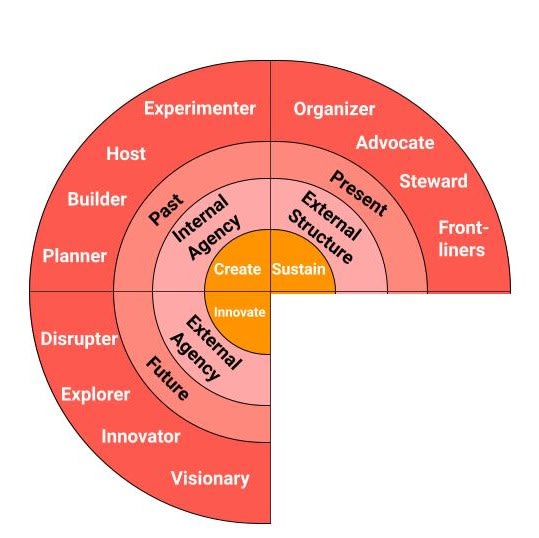

These communities are what make people deter away from communities. There is only accepted participation if it follows suit to what structure the community built. Because of the lack of Rejuvenation and Engagement, there is no pushback or change to existing structure can be made and are often toxic cultures that are all consuming because there isn’t a multi-tiered approach to engagement. Many cults, startup companies, and ideological groups operate in this matter where you must be all in, or there isn’t anything for you in the community at all.
3.7.4 Fixed Groups


Fixed Groups are the way the most communities, social movements, and nonprofits die. Most communities reach this point, and it’s one of the saddest moments a community builder can experience - losing Innovation in a community. Any community organizer that has bootstrapped from the ground up and has had to leave a community is because the component of Innovating is no longer appreciated and/or deemed “necessary” from the majority of other contributing action roles. A community organizer goes through all 4 actions to build up the community that needs to exist, however once the infrastructure of a community has been built, the only way to move it forward after structure has been put in place, is Innovation. Without Lurkers that follow the Innovators, there is no pool of people to move up the cycle of consumption to be a full Participant. Attracting Lurkers to graduate in the CCM should always be a priority in long-term community building.
3.8 IRL, Online, Hybrid
Previous to internet times, all communities were IRL and based off of surrounding physical engagement. Now with the explosion of digital communities in the past two decades, there have been centralized organizations that only interact through the parameters of the internet, and very few have ever had offline engagement.
However, the past decade has ripped apart our already declining in-person social infrastructure, because the platforms that we’ve utilized for communication have removed the purpose and incentives for in-person socialization. Because of this, there are many toxic patterns that we have absorbed into our social hygiene. In our pre-covid world, the existing social infrastructure was concurrently established and institutional relationships with existing communities.
During Covid, there was a stark conversion to digital means of participation, causing most existing IRL communities to dissolve in the past couple of years because they didn’t have the proper digital means to replicate their community’s true purpose. With a renewed sense of need in building community offline again, in-person communities have just begun to make a slow and even painful comeback with even higher barriers to entry. Because of this, navigating hybrid styles has taken a toll on most newer communities that have not had the proper structure to implement a hybrid approach.
Through social media, there has been an ever-changing hybrid model of digital communities to in-person and vice versa. The shared experiences are recorded and a digital layer has been introduced to cement the engagement for those that can engage digitally, and those that can engage offline as well.
The community action and consumption model can be used for either an IRL or online community. However, when it comes to hybrid, how do you combine the two of them? Do you use both models twice for the online version of the community and the in-person one? Here are the proposals that I’ve deemed as ideal for community participation:
3.8.1 Create + Rejuvenate / Participate + Engage

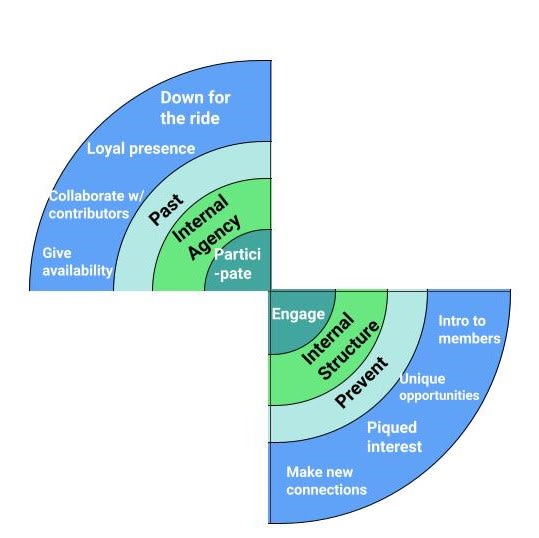
Of course, all original communities were all created in-person before there was the internet and smartphones, and most recently in the past decade, have had to convert to a digital layer for expansion of communication for in-person engagement and to grab the increasingly fleeting attention. The Creators and Rejuvenators were the most in attendance and the Sustainers and Innovators relayed online. Therefore Engagement and Participation were the operating consumption opportunities when coming in-person, and all Lurking and Learning can be managed digitally with quick ease. A great example of this is meetup.com - the breeding ground for digital to IRL pipeline and vice versa for rounded out communities. Their community model has been adopted by communities of all shapes and sizes and off of their platform as well.
3.8.2 Sustain + Innovate / Learn + Lurk
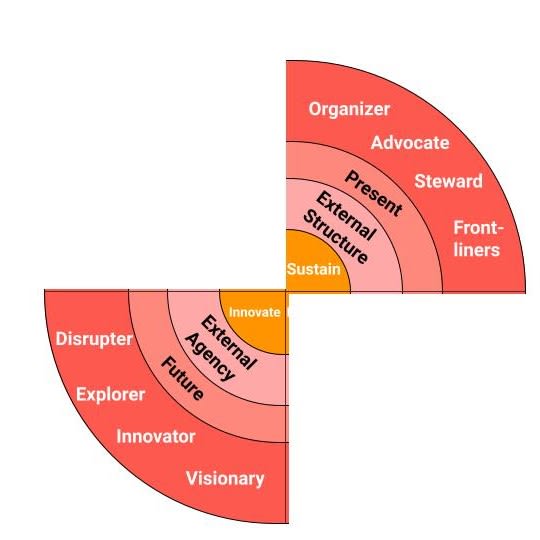
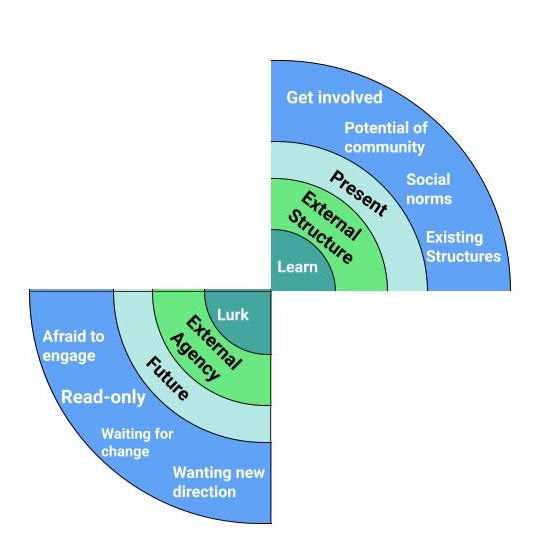
Nowadays, in a post-Covid world, the Sustainers and Innovators meet in person, while the Creators and Rejuvenators remain digitally for interaction. This is seen often in corporate and company settings where middle management Sustainers report into the office alongside status-hungry Innovators ready to take the next level up in their career. What doesn’t sit right in this hybrid approach is that the Lurkers and the Learners come out in-person - and really need a huge push to level up in their consumption opportunities. With the Creators and Rejuvenators stuck online, there is friction to Participate and Engage, unless the proper programs are in place digitally to facilitate these engagements.
The next stage for social technology is the hybrid approach to communities and will be difficult to master and achieve. The parameters are instantly doubled as the crafting of community experiences both in-person and online will now plague communities until the proper approach is discovered and applied. No longer can a community be in-person only or digital only - and in the long term, I’d like to test out the CAM + CCM in all hybrid scenarios.
3.9 How to apply this to your community
This is a workshop break to help those that are interested in making their personal and associated communities more productive with a holistic approach! Answer the following questions to see how you can improve your communities.
3.9.1 What contributing action role do you play for your personal community?
- What are your natural talents when it comes to bringing together your friends? What role do you play for your friends with the CAM?
- Which CAM roles resonate most with your natural talents?
- What are some skills you would like to improve upon?
- Which CAM roles are associated with the desirable skills?
- Place your top 5 friends in your personal community. What roles do they play? Fill them out in the empty CAM.
- Place yourself in the role you play in the CAM. Do you share any roles with your friends?
- What role are you? In consumption or action models? What action do you want to be? What role are you for your community you built around yourself?
3.9.2 How to be a better community consumer
- List out what communities you are a primary consumer of.
- Assign which consumption stage you are at with each community based off of the CCM. (Bonus points if you can give a timeline of when you graduated or detracted from each consumption stage.)
- Identify which consumption stage you would like to graduate at with each community.
- Identify which consumption stage you can detract from certain communities.
- Craft a strategy using the consumption model by moving up the consumption model through achieving full participation.
3.9.3 How to be a better community contributor
- List out what communities you are a primary contributor towards.
- Assign which contributing action you give to each community.
- Identify which of the roles you give to each community.
- Place the communities and roles into the CAM and CCM.
- Ask yourself, what other actions can I contribute? How do I reassign my action to someone else? What action do I want to try doing next? Who is someone in my community that can step up and be a part of a contributing action?
Section 4 - How EA needs to change their community
By now, you may have a high-level understanding of the blended techniques to create and sustain a community. However, this thesis is also for the purpose to critique and give direction to the EA movement - to deeply examine new ideologies and systems that have not been applied or further elaborated within the organization.
With the models and ideas I have presented on community building philosophy, I will now apply them to the EA organization at all different scales. Many of the ideas and critiques I will reference are existing forum posts from up to the past year for prime relevancy and up-to-date actionable items and the resources EA shares amongst organizers and community members for movement building. Effective altruism philosophically believes in the amount of contributions one can make throughout their life to do the most good possible, however, if they can’t measure the amount of good it takes to sustain the good they’re building, could it ever be worth it?
4.1 Current Stats
For a data-driven community, it is most beneficial to start with the current standing of metrics that EA can currently be measured by. Here are the most current stats that are available to measure the community that I could find available online. According to the most recent Time article, more than 7,000 people have signed a pledge to give away at least 10% of their income, more than 200 EA chapters around the world, and approximately 6,000 individuals will attend conferences throughout 2022. There are approximately 3-4 EA Globals/year and 6-8 EAxCity Events/year as seen on the EA Global site.
For EA platform presence, there are 11K posts on the Forum, however there is no confirmation on the amount of users active and registered on the Forum. There are 21.5K Facebook group members in the main EA group, 7.77K Youtube Subscribers, and 21K Twitter followers from official channels. There are no official Instagram, TikTok, Twitch accounts or other verified platforms. That’s it.
We often measure communities by numeric metrics of what amount of people are engaged, however we never consider the mechanics of treating the organization as an organism - ebbing and flowing to a thriving place or death before it truly begins. Even in this short analysis of where EA stands numerically, there are many missing metrics of what would define a fully rounded community, let alone one that is ultimately effective and operationally efficient.
Even if we collectively added up every single metric and considered each person a unique individual that is under the EA influence that would add up to approximately 63K impressionable minds. Based off of numerous estimations, many people in the community believe EA to actually be a movement of around ~10K-15K people, and that is of course, being generous. Naturally, there will be cross-over between platforms and the actual number of unique individuals that would participate in EA is much lower, but that begs the question - who and what is an EA community member?
First collective action item for the CEA team is - what defines someone as part of the EA community? And secondly, how is the Community Health Team tracking these identifiable EA community members? Until there is a definition of the lowest threshold metric of a community member, it is difficult to expand and grow the movement beyond just a vague term of “EA community member”.
4.2 Who are the people that make up EA?
One of the biggest pillars of the EA community is the prioritization of movement and community building. Seeing as such that community has become such a bloated word, I’d like to stem off a few definitions of what community contributors may mean for EA. There are the community members that donate to EA, the community members that contribute to the Forum, the members that contribute throughout social channels, and the silent majority that support EA philosophically, but do not engage or participate in EA’s community.
The current social incentives and currency created by the EA community are to donate, get karma on the forum, host a local club, and/or be hired by the CEA or EA-aligned organizations. This is too shallow of the nuance and potential depth the EA community could build in order to foster a more dense and socially rich space to reward varying levels of productive participation.
Some questions EA should be asking while defining community member personas are:
- Who are the people that EA are looking to recruit?
- Who are the people that are currently part of the EA community?
- Who are the core community personas that EA is looking for?
- Who are they missing that can join EA?
- Are they willing to sacrifice a certain defined “quality” for the quantity and expansion of the movement?
Until these questions are resolved, EA can never define the proper community personas that they funnel into the CCM for proper Participation in the EA community.
4.3 What are the community objectives and metrics?
The EA community and movement have changed over the years and the objectives have shifted. Despite this, there is not much literature on the tangible objectives and metrics for what EA’s community should actually be building. What are the current community objectives and metrics?
For example, this is what an objective and associated metric should look like:
Grow the EA Forum content posts.
→ In Q3 grow EA Forum posts 5% than previous quarter. In Q4 grow EA Forum posts 7% the previous quarter.
In order for the objectives to be aligned, EA's team needs to align the values of the organization and apply it to the goals that are needed to move forward. Some questions worth considering defining community objectives and metrics:
What are the community priorities for each quarter? Half year? Annually?
How aggressive are EA’s plans to expand?
What can be quantified in this community program?
What is considered qualitative in this community program?
What is aspirational and what is necessary in community development?
Without community objectives, there are no north stars to achieve and the shared community work cannot be properly delegated.
4.4 Why does EA’s Community need to change?
These are community-led points that show why EA's community needs to change regardless of my personal opinion.
4.4.1 Consistent Criticism
The continual critiques of EAs from outside of the community lead to a few different roads. I see these people who share critiques as potential Innovators of the community, however they have left - due to the EA community not taking what is said seriously, and certainly not implementing said critiques. It is also just long-term bad PR practice with many negative digital footprints compared to an average “charity”. This leads to more than average churn away from the movement because there will be a pre-destined sour taste on an impressionable person.
4.4.2 Lack of Organization
Due to the many moving parts of the movement, there are so many break-off points that do not make the EA experience reciprocal. There is also frustration from many EAs that there are too many community builders but that takes away or disproportionate to the actual work needed for cause prioritization and action. This leads to disjointed participation which creates a high rate of churn that can be fixed with the right mindset to streamline the EA experience.
4.4.3 High Bar of Participation
The Elite EAs only consider someone to be an EA through high-level participation and after passing a certain threshold. While this is ideal for a small focus group, it is not desirable to reach the ambitions of the movement to be a global cause and drive doing the most good for the people of the world. This prohibits movement growth because the areas in which people can participate are ill-defined and limited.
4.4.4 Inner Org Politics
Any organization that is founded based on morals will absolutely have issues surrounding inner organization politics. EA is still a fairly centralized movement in terms of assignment. The movement building indoctrination starts with identifying the origins of how the community was built up and which practices were taken to get there. It is unfortunate that many of the innocent community builders across the globe have been provided documents and questionable guidance that are running them into a rut of burnout with little to no hope of a better process. I genuinely question the intention of these models as if switched with religious theology, there would be much more commotion and critique and the cult / religion-based engagement.
4.4.5 Disillusionment
Many EAs have left the movement to varying degrees of EA’s lack of agility and ability to adapt as an organization for the many growing pains it has had. This has come off in a variety of pessimistic takes and begrudging nods towards moving away from the movement. This leads to many people that want to participate but choose to lurk instead - waiting for the innovation needed to become inspired again.
Fortunately, these are friction points that can be absolved. The work? It lies ahead in fixing up many of EAs existing programs at a smaller scale, and larger scale organization infrastructure to revitalize the community and movement to be more operational and sustainable for its longtermist future.
Section 5 - How does EA fit into the CAM or CCM?
Frankly, EA does not fit into the CAM or CCM on a macro and micro scale. They are skewed in several fixed powers for the current state the community is operationalized and must really take a step back to build and replace the infrastructure to prop up the necessary proper foundation. Through this part of my essay, I will dissect EA’s community building models, give examples of where EA currently stands in the CAM + CCM, and how to improve their programs and platforms to round out and be a more ideal, well-rounded, and functioning community.
*Disclaimer* In the following passages, I make claims and predictions that are modeled and based off of my previous experiences in community building, management, and industry work. I would love to work with someone that can mathematically model community building practices - these are just not my natural talents and would need a collaborator to create further accuracy. :)
5.1 EA’s Community Building Models
Ironically, I had already created my entire philosophy before an EA peer had sent me the resources and EA’s community building models that are shared with all EA organizers for movement building. There is already drastic conflict to start.
5.1.1 The Awareness/Inclination Model (AIM)
5.1.1.1 Figure 1
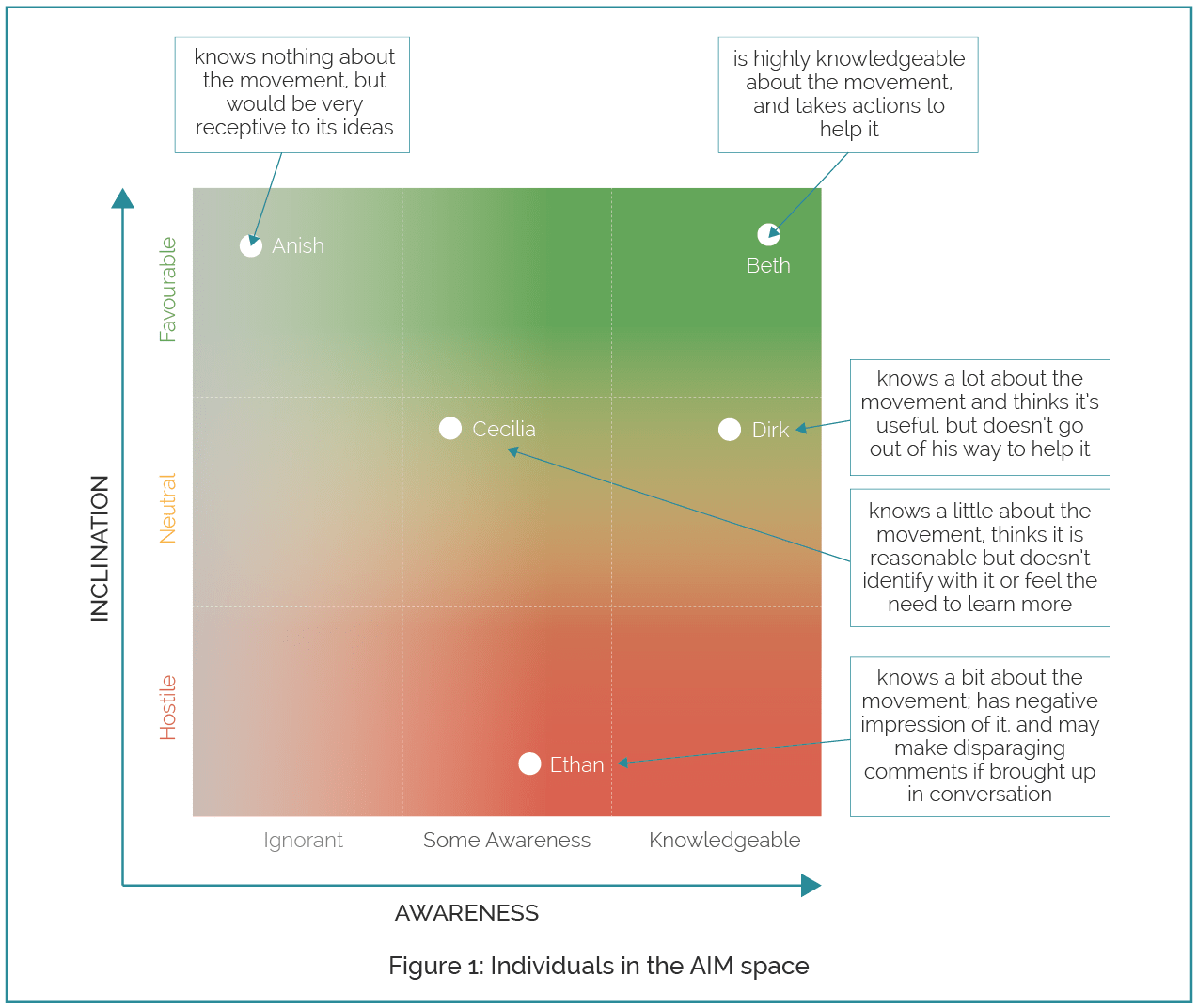
In Owen Barrett’s AIM, “the modeling assumption is compressed down to two dimensions: awareness (how much they know about the movement) and inclination (how favorably disposed they are towards the movement, or how favorably disposed they would be if they knew more).” If we put them into my CCM model, this is trying to achieve the axis of Lurk (Inclination) to Learn (Awareness), however the parameters of his model are not complete as he implies as there is no actual axis of Participation. While I appreciate the specification of inclination of hostile, neutral, and favorable areas of convincing someone to engage in the movement, this is antithetical to organization building. This model also only appeases the CCM instead of both CCM + CAM. Let’s divide his examples of people in his model into the CCM:
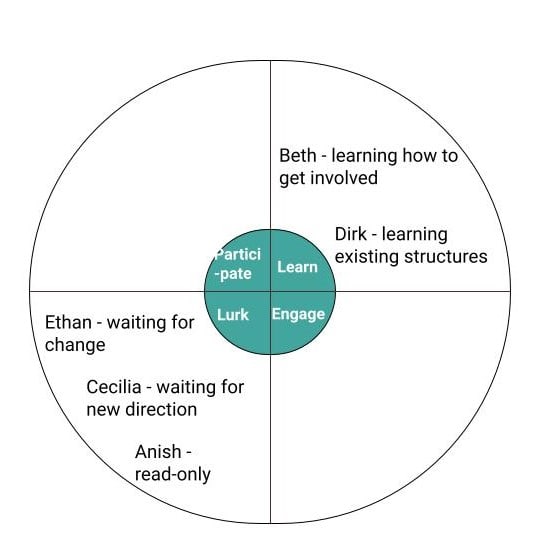
While the community consumers were at varying degrees of inclination and awareness, they still only boiled down to Lurking and Learning. The axis of being hostile, neutral, and favorable towards a movement’s ideology is missing the point of the fact that being convincing of ideology does not necessarily lead to active consumption. Without Engage or Participate as part of the AIM model, there are only limited formats that potential community members can . This is addressed in the hybrid part of my essay in Section 3.8 as well.
5.1.1.2 Figure 2
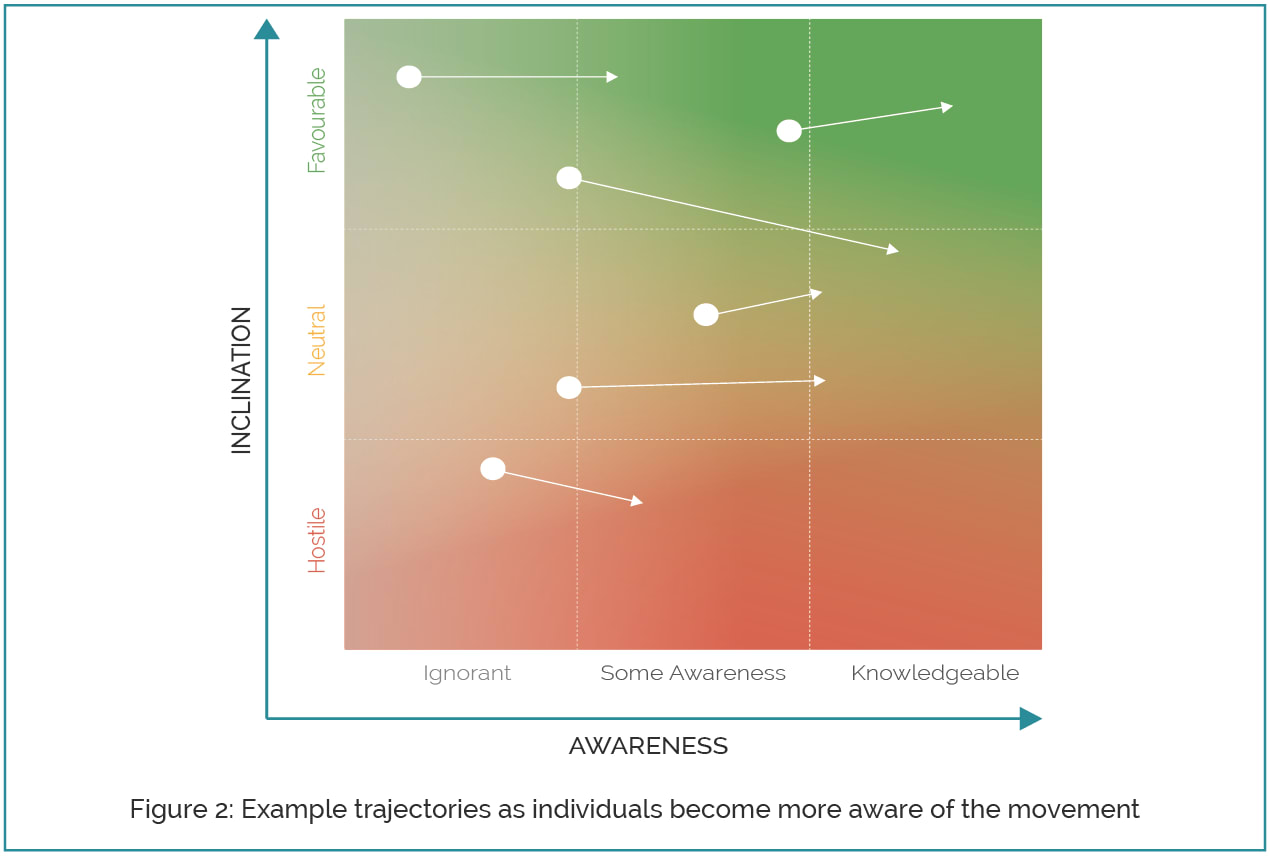
The implications of the AIM are that people’s inclination levels are dependent on the scale of awareness and to achieve highly favorable and knowledgeable status. This is debunked again by my CCM in Section 2.9 that people can graduate and detract from different levels of consumption of a community. As defined in the CAM, if a community lacks Innovation, it will lack the Lurkers that graduate into Engagers. This model does not take into account that people move backwards and that is not correlated with hostility.
5.1.1.3 Figure 3
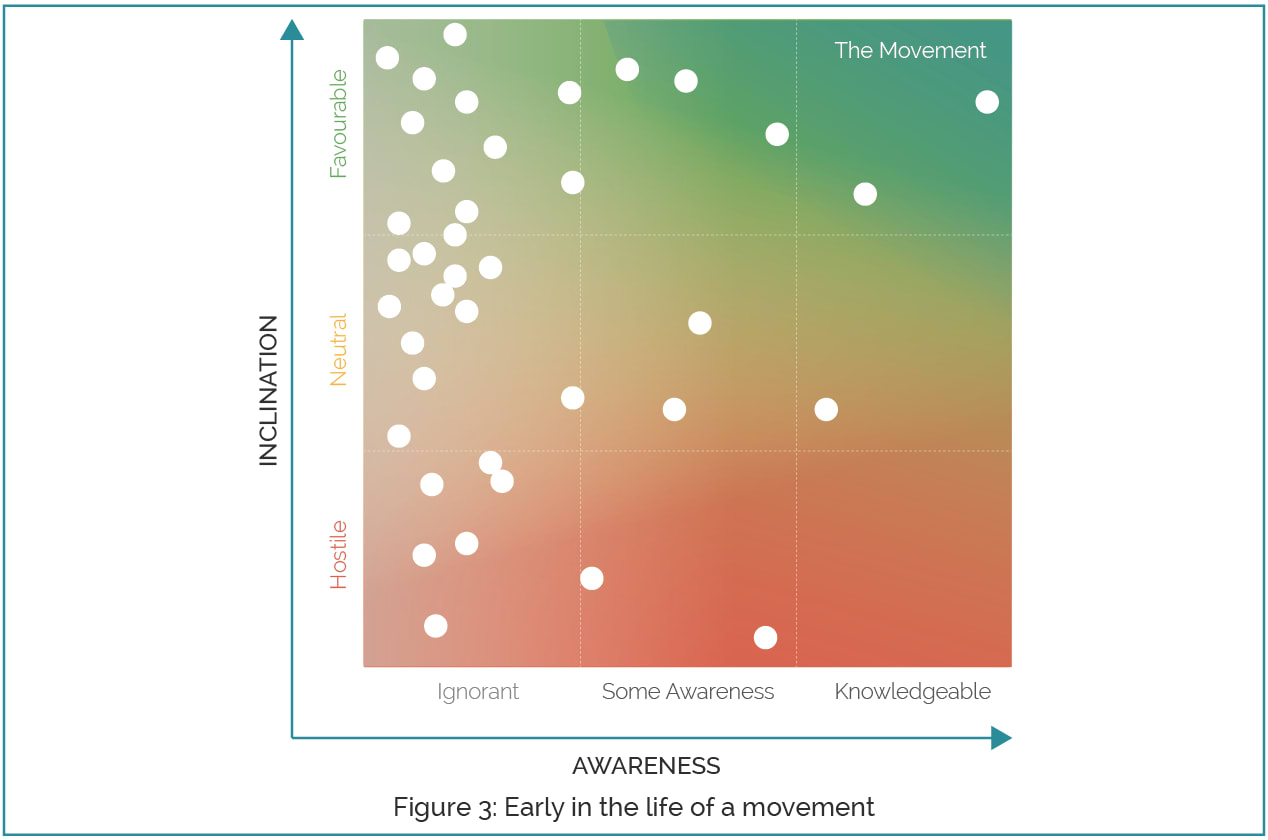
In Figure 3 of the AIM, the early life of the movement is also incorrect. The opposite is typically achieved at the beginning of a movement. As described in Section 3.1, the community starts at Innovate/Lurk + Create/Participate. The highest level of participation is achieved until the community’s foundation spirals outwards into Sustaining, Rejuvenating, and then Innovating to complete the cycle tenfold over. The AIM implies only covers the people in a fixed environment that are to be convinced into movement building, but it does not address how these people will be convinced and engage further even if they are favorable.
5.1.1.4 Figure 4
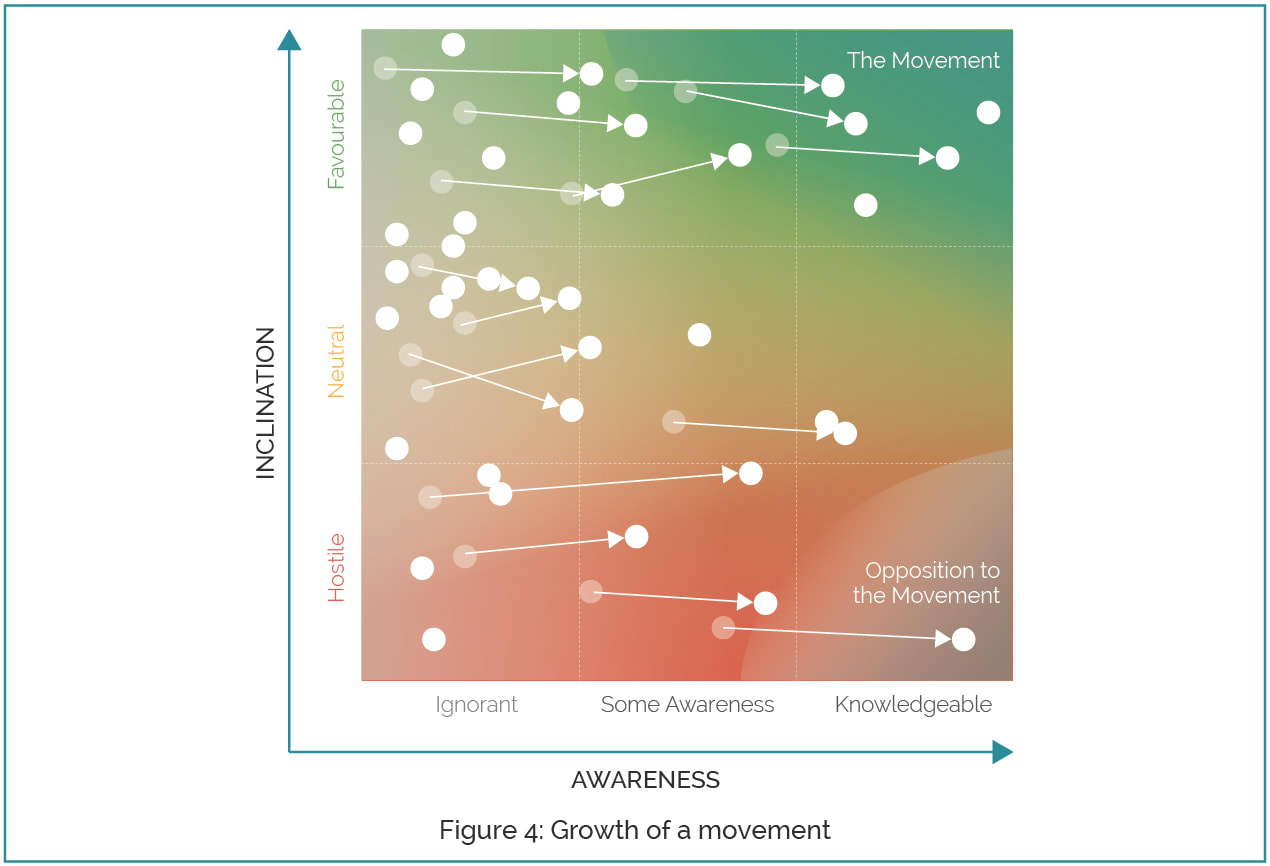
Opposition to a movement is not necessarily a bad thing, but it is an indicator of why someone remains to be knowledgeable of the movement, just “hostile” as its overall outcome of “engagement”. As defined in the Lurk category of the CCM, the Lurking is the biggest indicator of how much Innovation is happening within the community. As addressed in Section 2.8.1, some of the biggest Lurkers are the most knowledgeable but are opposed to participation because they seek Innovation to begin their consumption journey into Engagement, Learning, and then Participation. Hostility also implies being unwilling and/or afraid to engage with is directly correlated with the amount of Disruption within a community as defined in the same section. Opposition is only an issue if it is about compliance with Participation.
5.1.1.5 Figure 7
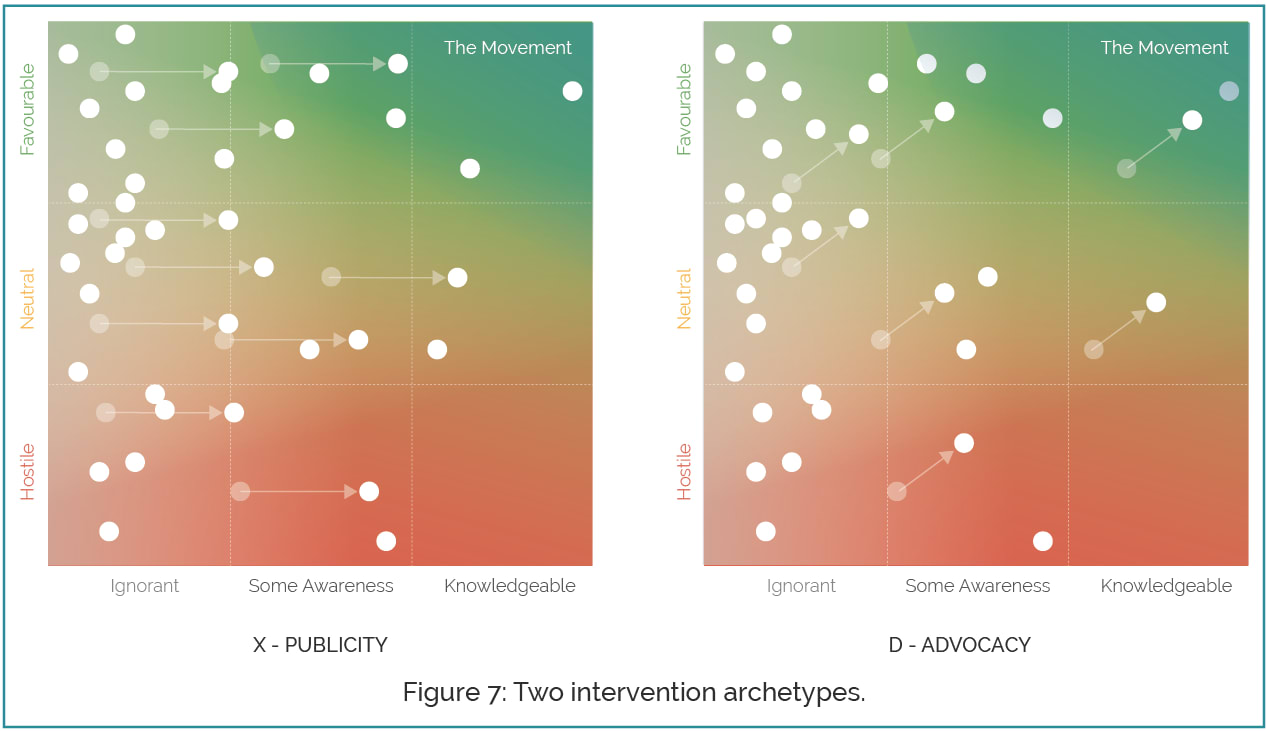
In Figure 7 of Publicity, the CAM supports this through Rejuvenate in Storytelling and CCM in community consumers Engaging in piqued new interests and opportunities. This however is not the only mechanism for consumers to graduate into Learning more about the organization.
I agree with Figure 7 of Advocacy that it is what helps change people’s general reception towards a movement. This is supported in my models as the role of CAM Advocates in Section 2.5.2 and producing the chain reaction of the CCM Learn of the movement’s potential in Section 2.8.3. However, Advocacy isn’t enough to get community consumers to Learn enough to graduate to fully Participate. There are no data points for the Organizers, Front-Liners, and Stewards as mentioned in Section 2.5.2 which do not complete and make Advocating a full community Action of Sustaining a community.
5.1.2 The Fidelity Model of Spreading Ideas
According to the Fidelity Model, this EA model is for the purpose of understanding how EA ideas can spread and the potential reach. Their definition of calculating fidelity is through the following questions:
Breadth: How many ideas can you explore?
Depth: How much nuance can you add to the ideas?
Environment: Will the audience be in an environment that is conducive to updating their opinions?
Feedback: Can you adapt your message over time to improve its fidelity?
EA also has an emphasis on identifying and separating low fidelity to high fidelity interaction and spreading of ideas. This is debunked by my CCM as there needs to be low fidelity interactions in order to achieve high fidelity interaction. Without the range of low fidelity interactions or “Lurk + Engage”, there can never be high fidelity interactions such as “Learn + Participate”.
They are worried of diluting the movement by continuing to engage in low fidelity interaction - but as proven through the CAM and CCM, there needs to be a actions first before producing consumption opportunities. For the record, this isn’t even a model - this is just a conversion tactic and technique of spreading ideas.
5.1.3 The Concentric Circles Model

In the concentric model, EA defines how the entire organization should sit based on their interpretation of “engagement”. By “engagement” EA has explained it to be “a combination of three highly correlated factors: engagement with our ideas, dedication to act, and engagement with our community.” Engagement is another over-bloated word as why I had to define why there are 4 actions in the CAM + CCM. There needs to be more specific nomenclature as to what engagement means with and within an organization.
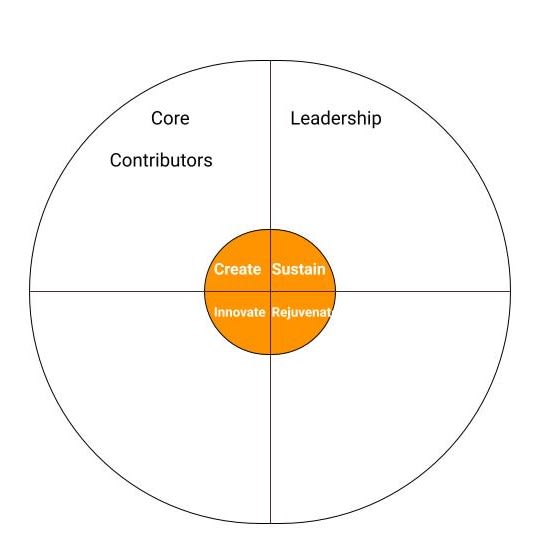
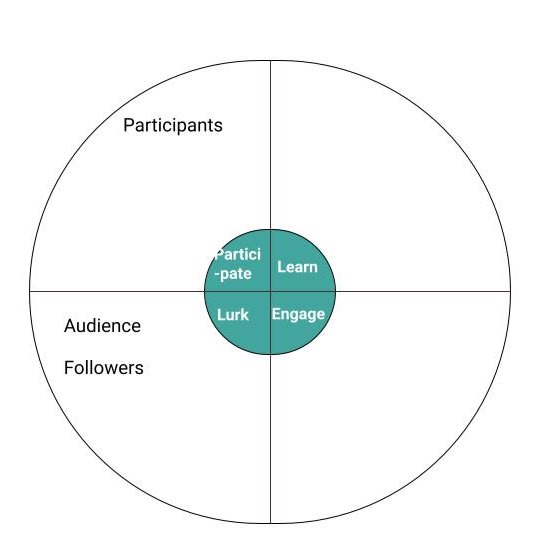
By dividing it into the CAM and CCM, this is where EA’s concentric model fit into from an Action and Consumption based lens. Pretty imbalanced, right? The concentric model conflicts with my CCM as it only allows for Lurkers and Participants for the EA consumers which is a heavy lift for those that are questioning their purpose and defining contribution they want to give to the movement as addressed in Section 3.1. Additionally, the CAM debunks this as there is only representation for Creators and Sustainers but there is no Rejuvenation or Innovation in their process as mentioned in Section 3.2. Leadership should be across the disciplines in the community, not only at the center which is the first of many red flags of the management and “core” of the EA community.
The concentric model is also proving to be faulty since the contributing actions are not directly correlated with the consumption opportunities. What does this mean? They are expecting consumption results when they haven't even created the community actions to produce said consumption results.
5.1.4 The Funnel Model
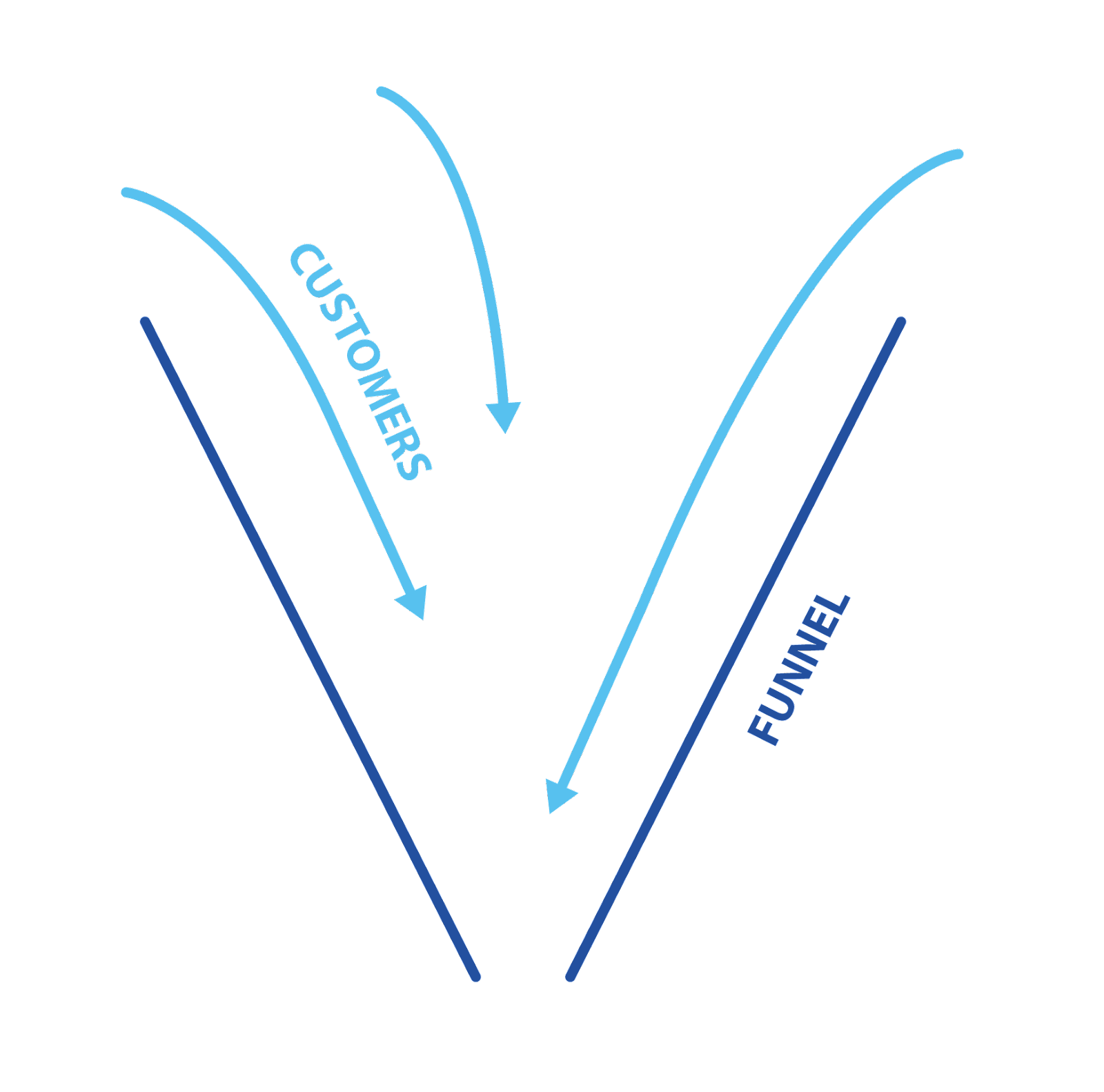
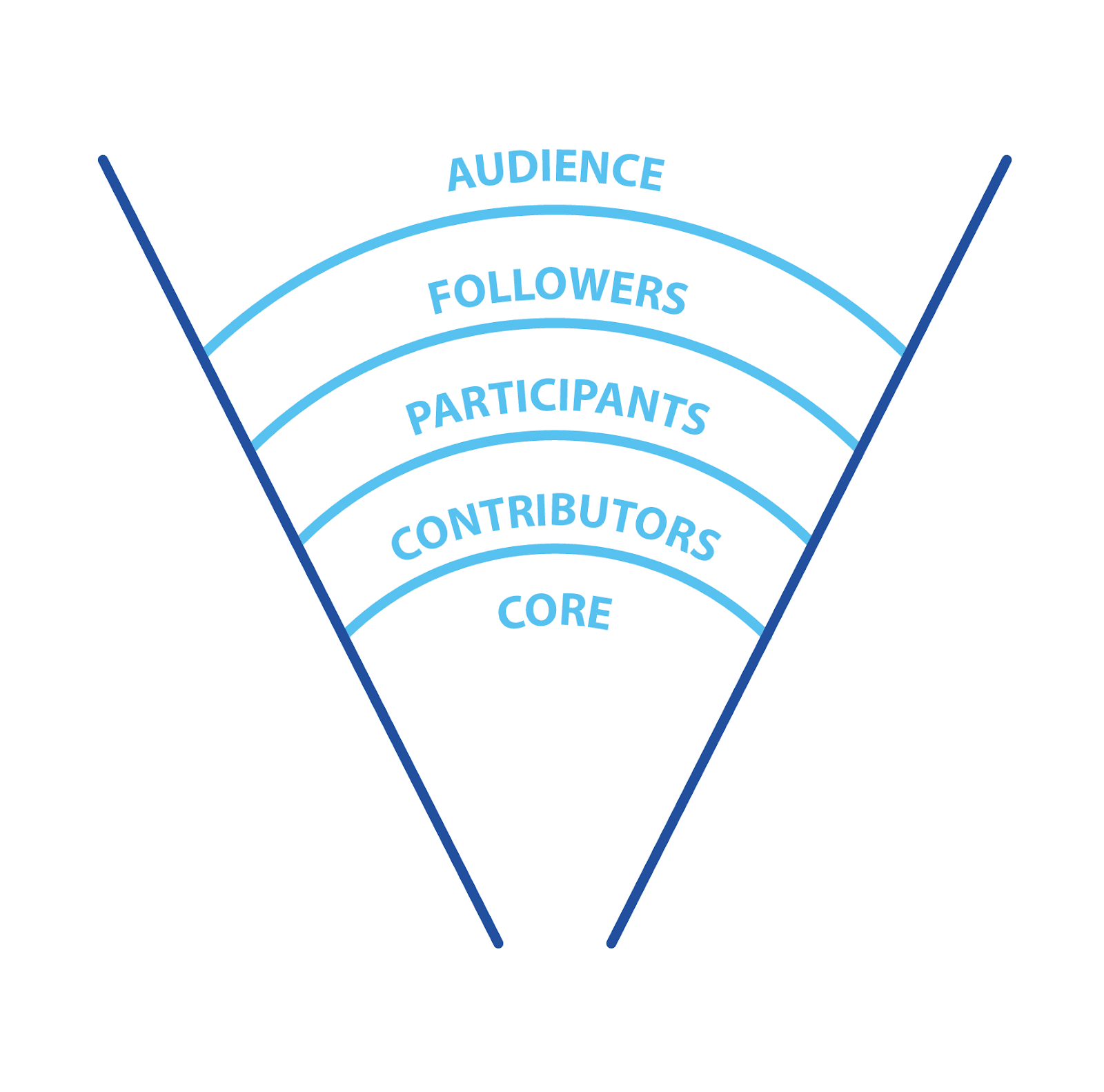
EA’s funnel model is also flawed as established in my CCM. In order for any funneling to happen in the CCM, it is dependent on the CAM to have a chain reaction of where consumers turn into active participants. It is a symbiotic relationship, not a tiered and trickle-down relationship that EA’s community philosophy implies. So, when you have a trickle-down approach of who is allowed to participate but must follow, you get sparse and dense participation, without the breadth to expand the community further than just the elite group that checks off all the social currency boxes.
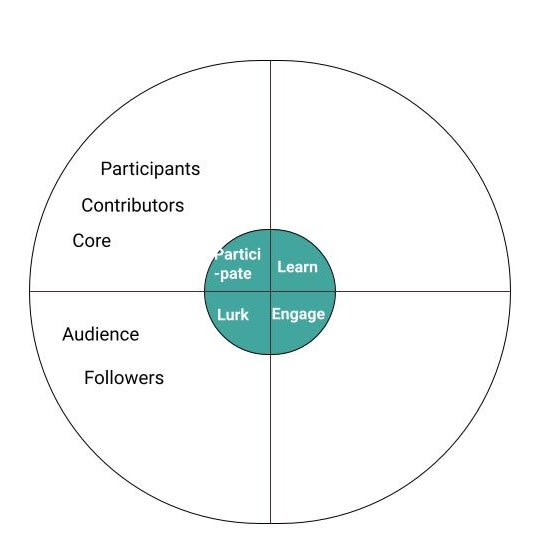
So with the Funnel Model which is their adjacent CCM, there are only ways to Lurk and Participate from a consumption standpoint in EA. This is referenced in Section 3.1 and is really a beginning aspect of how a community is built, but not sustainable long-term as it requires such a high bar of expectation leaving high amounts of churn within the community since most people are not willing to commit to that degree.
Even as defined by the concentric models of who are part of which concentric circle of participation EA, there are not enough roles within the EA community to make it a sustainable organization. To diversify the potential demographic surrounding the discourse, there needs to be other platforms and programs to best engage the community instead of a linear and lateral form of engagement. It would be ideal that everyone had the autonomy to seek and identify where EA fits into their life, and not an all or nothing approach that the current movement provides.
5.1.5 A Three Factor Model of Community Building
According to EA, these are the three most important metrics to define how EAs can contribute to movement and community building. Here are their definitions:
Resources: The scale of the resources (money, skills, etc.) they have to offer;
Dedication: The proportion of those resources that they devote to helping;
Realization: How efficiently those resources devoted to helping are actually used.
These are all great in terms of the “work” EA is trying to achieve. But none of these 3-factors are relevant to sustaining the organization and movement of EA. Raising capital is not the only method of EA’s movement and if it was, well, there wouldn’t be all of this commotion.
While these three factors are not congruent with the theory of the CAM + CCM, they can be redefined into adjusting an improving the model.
Resources can be co-opted by the CAM as what are the varying skills of the 16 roles identified through the CAM. These resources should be prioritized as people's talents to sustain the organization as a whole.
Dedication is at the height of Participation within the CCM. These are all high-bars to achieve, but there is no technical language for a non-to-beginner EA to begin the process. Dedication can be another layer added to the CCM, but it actions are not defined by dedication in my honest opinion. One can be dedicated to Lurking EA, and never graduate to Participation within the EA org.
Direct Work needs to be defined into two categories now. Are they direct work as in EA causes direct work, EA-aligned career direct work, or EA community building / movement direct work? This needs to be established as separate factions within the Participate quadrants of the CCM when EA decides to apply how they want their community consumers to Participate.
5.1.6 How EA’s Models Work Together
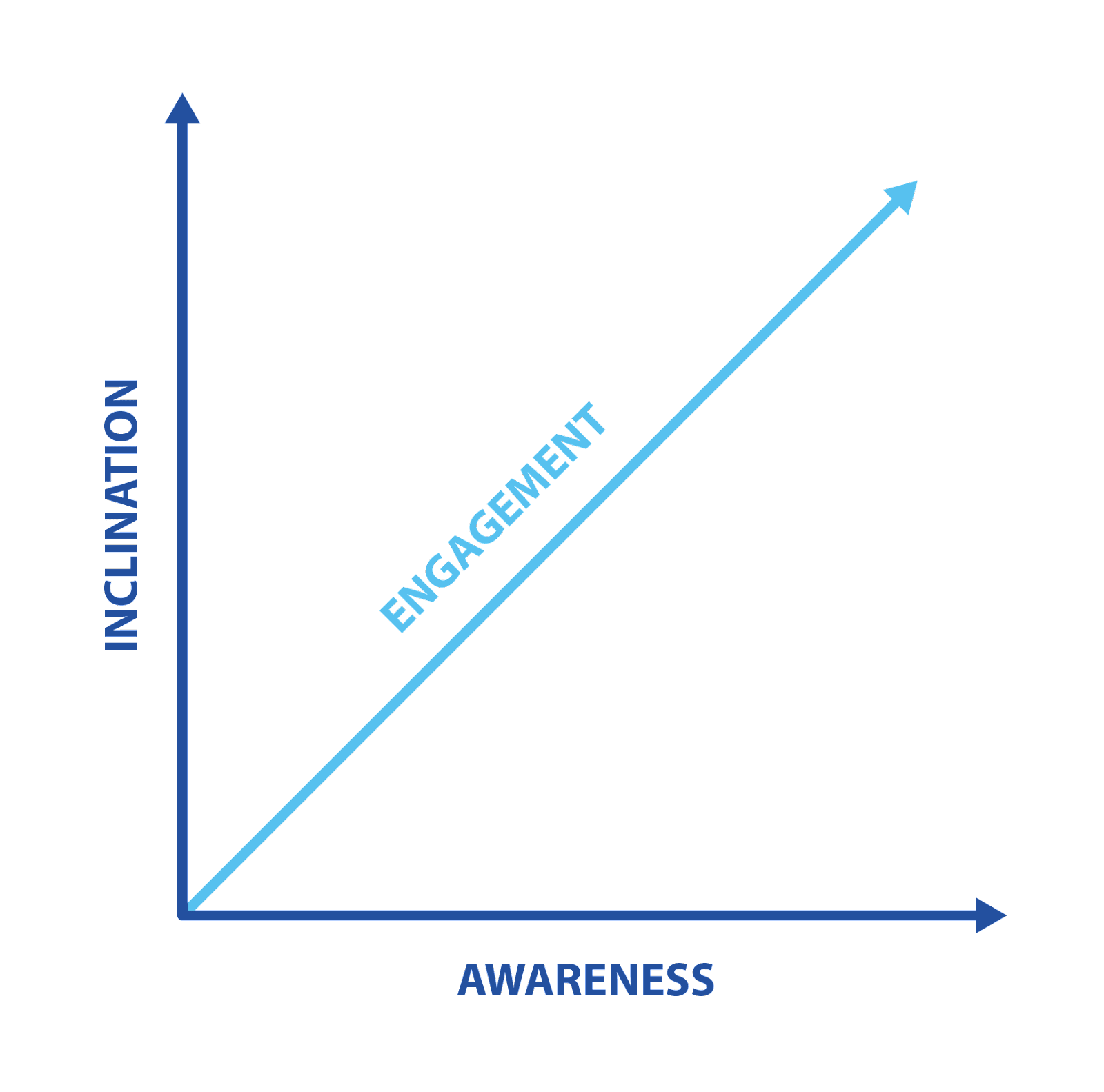
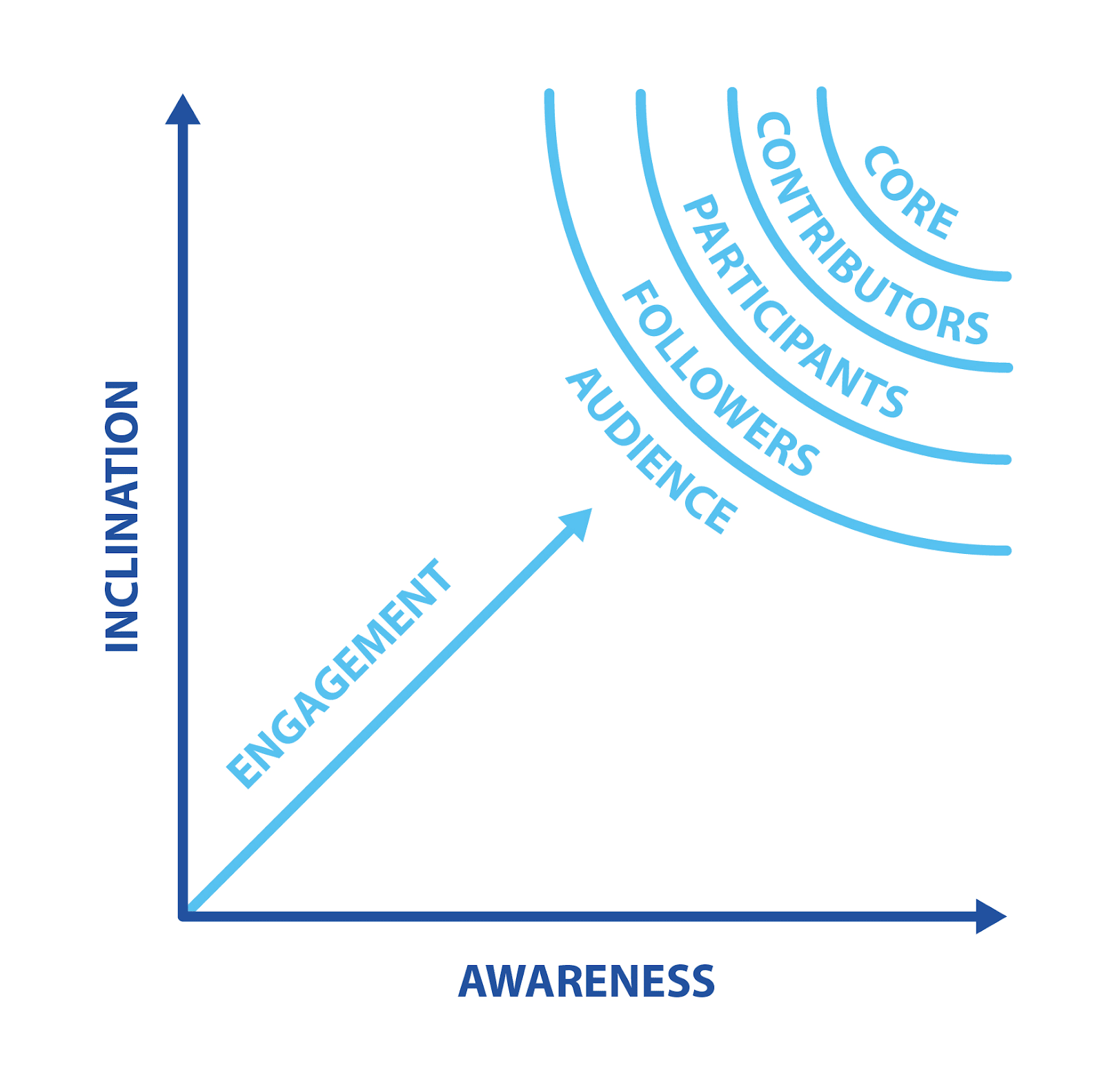
Fundamentally, EA’s community building models are disjointed and inconsistent across the board, and is now reflected in what the movement and community has built up to. Once again they have now added Engagement but created the wrong axis without truly preparing for full Participation.
5.2 EA in the CAM + CCM on a Macro Scale
Now that EA’s community building models have been shown to have blind spots and flaws, we now need to turn to the CAM + CCM in how to restrategize and reconsider where the EA movement currently stands.
Based on the terms utilized in the EA Concentric Model, I have used their specific definitions of identifiable priorities for the organization to target and what the EA approved channels are for participation. This has been assigned into the Community Action Model and Community Consumption Model below to show the division of shared community work EA has currently achieved.
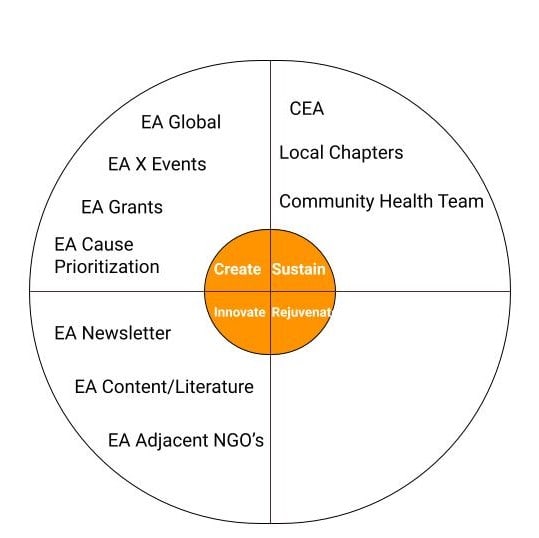
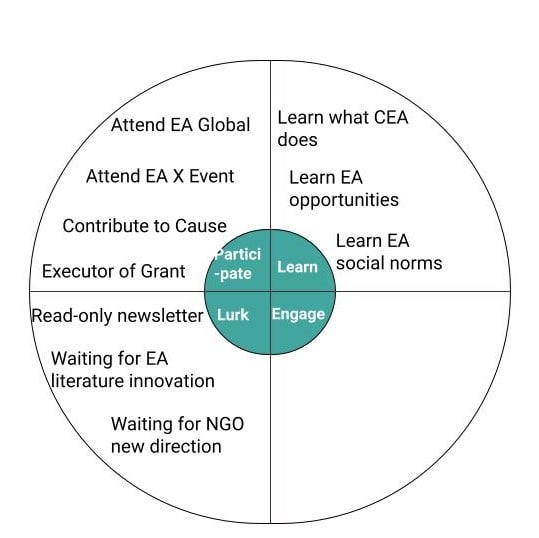
In the CAM + CCM terms:
Create:
EA Global → Host → Participate → Attend EA Global Event
EA x City → Experimenter → Participate → Attend EA x City Event
EA Grants → Builder → Participate → Collaborate with Grant Executors
EA Cause Prioritization → Planner → Participate → Give availability to cause areas
Sustain:
CEA → Organizers → Learn → Learn what CEA does
Community Health Team → Front-liners → Learn → EA social norms
Local Chapters → Advocates → Learn → EA opportunities
Rejuvenate:
N/A
Innovate:
EA Newsletter → Disruptor → Lurk → Read-only newsletter
EA Content/Literature → Innovator → Lurk → Waiting for EA literature innovation
EA Adjacent NGO’s → Explorer → Lurk → Waiting for NGO new direction
As the model displays, the EA organization as a whole is lacking in the Rejuvenation department. As defined in my community philosophy, EA is actually a “Toxic Group” (Section 3.7.3) that only gives its constituents high-level Participation with little to no opportunity for Engagement for EAs that are not ready or willing to be at full Participation yet. From the CAM perspective, there is no Weaving, Matchmaking, Caregiving, and Storytelling efforts to refill the cup of the exhaustive EA journey. From the CCM perspective, there is a huge leap that community consumers need to take from Lurking to high-level Participation which has been established from EA’s models of how they built their entire movement and community.
Additionally, the Hybrid Community technique as mentioned in Section 3.8 is also not properly achieved through EA’s organization. EA by default is a hybrid community due to its wider reach online than its current in-person participation, and has not mastered the balance between the digital and in-person engagement. Currently, the in-person engagement is fixated in Create + Sustain with Participate + Learn, which once again shows how high of a bar it takes for a non/potential EA to be able to even attend any EA type of event.
Why does EA not fit into the CAM + CCM? These are the consequences of poor organizational planning and unacceptable sacrifice of not prioritizing and measuring the effectiveness and sustainability of their own community. This was the direct consequence of subscribing to ineffective community models that facilitate militant religious conversion instead of proper organization building and resourcing. Although, not all hope is lost. The best mediation of all these problems at the current scale of EA is to round out its practices by utilizing the CAM and CCM on the macro and micro scale.
To analyze EA on a micro scale, I have robustly detailed the existing programs and new ones to fulfill each of the 16 community actions for the survival of EA. The next points in my essay will detail how existing programs do not fit the CAM and CCM and how to improve their prospects for the betterment of the sustainability of EA.
5.3 Where the EA Community could be at its fullest form
5.3.1 Diagnosis
The EA community is has grandiose ambitions to make EA a movement for the masses. Their actual reach is far from where they want to be as a movement.
5.3.2 Proposal
This is the CAM I propose of where I think EA could be in the next 1-1.5 years. These are the proposed programs that could better enhance the sustainability of EA. These programs will be addressed in Sections 5.4 - 5.9.
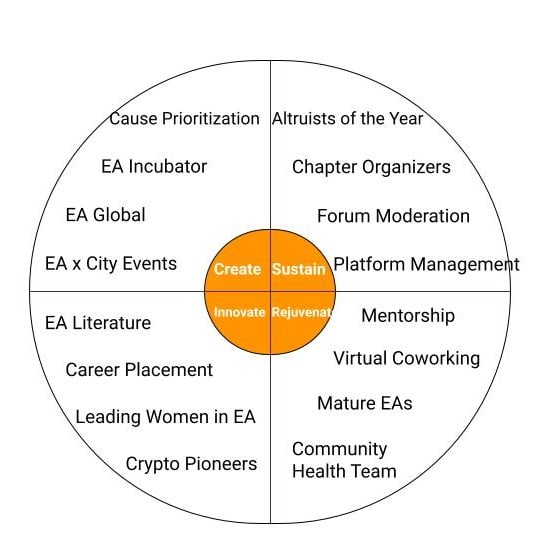
5.3.3 Action Items
Create community objectives and metrics. Assign these metrics and objectives to every program that is associated with the EA community. Have quarterly, half year, and monthly goals. Take inventory of existing programs and reassess their effectiveness. Apply all existing and new programs to the CAM + CCM to understand all of the community consequences they currently live in.
5.3.4 Ideal Outcome
Do I believe EA will be adopted by a billion people? Certainly not. However, I think it is achievable to get into the 100K-200K range in the next 10 years if my strategies listed below are adopted fairly quickly. Once the core foundation is set and agreed upon in rebuilding the movement with a new community building model, the programs can be built on top to last sustainably.
5.3.5 Null Case
If EA does not restructure it's community's foundation, it could be labeled as the millennial’s chapter of utilitarianism that never quite got off the ground. The movement has already gone on for 15 years and gotten to today’s point. While the fundraising is impressive, the sheer magnitude of what the organization has claimed has not been fulfilled and still nowhere close to it.
5.4 An EA Program in the CAM + CCM
I wanted to give an example of how EA should utilize the CAM + CCM on a micro scale for one of their most problematic programs - chapter organizers. If EA plans on changing their community foundation, this is the level and attention to detail that each program should have when put into planning and execution. This example strategy can be replicated for all of the other programs that I have suggested in Section 5.3.2.
5.4.1 Diagnosis
With a community like EA, most of its potential members to funnel into participation will have heard and maybe engaged digitally through the resources of reading. However it is problematic for the potential members that want to step offline, to have their first real EA experience as a chapter meetup and it is not cohesive or fundamental enough to the main brand.
These limited roles can be seen below in the CAM and CCM.
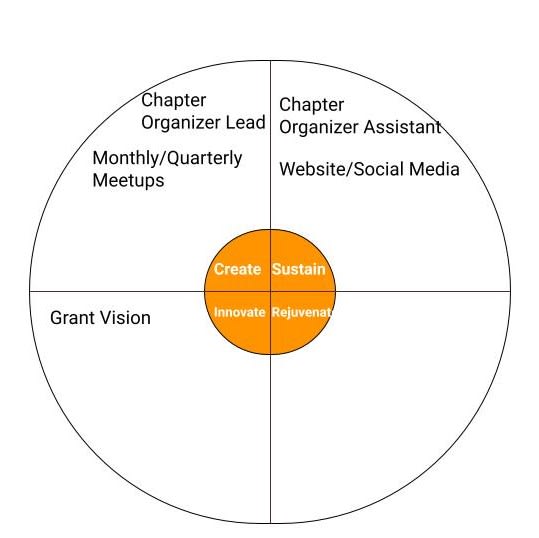
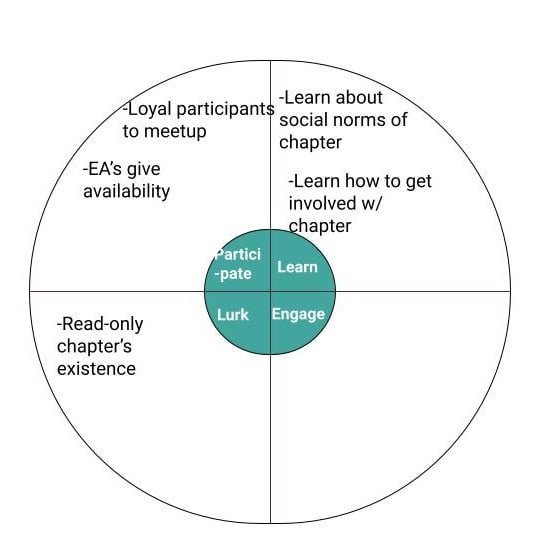
Based on the current infrastructure, there are barely any rejuvenating or innovative qualities and actions toward the EA chapters that are created. These are the bare bone structures that most of the EA chapters operate from and need a serious overhaul to become thriving individual chapters that they seek out to be. I empathize with the chapter organizers as there is too much of a focus on outreach, and absolutely none on sustainability. This is partially the fault of the models that are shared amongst the organizers. The Concentric Model in Section 5.1.3 shared amongst organizers defeats the purpose of any Innovation or Rejuvenation. It creates a structure that is fundamentally self-limiting and does not allow for an expansion in the types of roles the community allows people to participate in. Also the Fidelity Model in Section 5.1.4 show that the priorities of EA are in in-person engagement, and yet the in-person engagement for potential EAs is inaccessible and rudimentary.
With 200 chapters for such a tiny community, this is disproportionate to the impact the organization should be having and its chapter program has failed more than it has even taken off. Even if there were 200 active chapters, which many have been dormant for months if not years, if there were only 100 active members in each chapter - that would only lead to 2000 active EA members. How could that ever scale given how much effort and work is taken into each account? The events are not even updated on the main website for each chapter so it is increasingly difficult and decentralized to even join one chapter. All in all, the EA chapters are a hot mess and are not only unorganized, but inefficient as well.
5.4.2 Proposal
Consolidate all chapters onto one platform and make chapter organizers mandatory. If they were to stay insular, they would need separate identities, purpose, and action, to be fully effective, instead of breaking off the engagement in the community.
Incentivizing students to be ambassadors only lasts as long as the semester sustains - and helps build their resume, with a turnover that is a headache for the main community management team. What would be more sustainable is to adjust the university chapters and transform them into a student ambassador program to work alongside long-term community organizers. This would be more effective than having a high turn-over rate and inactive chapter division. Additionally, solely based on universities spanning a major city.
5.4.3 Action Items
The digital platform that would be able to achieve chapter organization is Bevy. It would regain the control of the main brand and be able to keep SSO with the Forum and give profiles to the EA Hub. This would cease the need for all independent websites. Social media accounts are ok but not ideal and could help EA create an actual structured brand.
Create objectives and KPI’s for the chapter organizers to hit. What are the key performance indicators that make a chapter effective? EA claims there are 200 chapters, but how active is each chapter? How many events are held per quarter/year? How many people attend the chapter events? What cause areas are covered and contributed towards in each chapter? How many events per quarter / year? How many attendees at each event per quarter? What is the curriculum of EA content that is approved? What EA approved content is shared and distributed amongst new EA chapters? How are chapters rewarded for succeeding and sustaining?
From my understanding there is a "Community Ramp Program" led by EA to facilitate better interaction and collaboration with EA chapter organizers and give them the resources to succeed. However, it still seems many EA chapters are not quality in membership, high in membership, or consistently producing the EA brand and programming.
5.4.4 Ideal Outcome
With the chapters consolidated, there will be fewer chapters but the impact will be significant. The chapters should be slashed down to 50-75 chapters that span major cities and then the chapter organizers can work with different regions, and/or causes that either span locally to international. Most chapters probably do not span more than 50-75 people within the entire group - this can be bolstered to 200-300 people per group with an average of 50-75 people in attendance per event.
There needs to be a weaving strategy of chapter organizers that can connect their loyal participants into allotting participation with cause areas to facilitate a match made for collaboration. It would also be ideal if the chapter organizers can be a facilitator for cause owners and career placement on a local/national scale. The people that come out in-person should have the same opportunities as the EAs that only digitally engage.
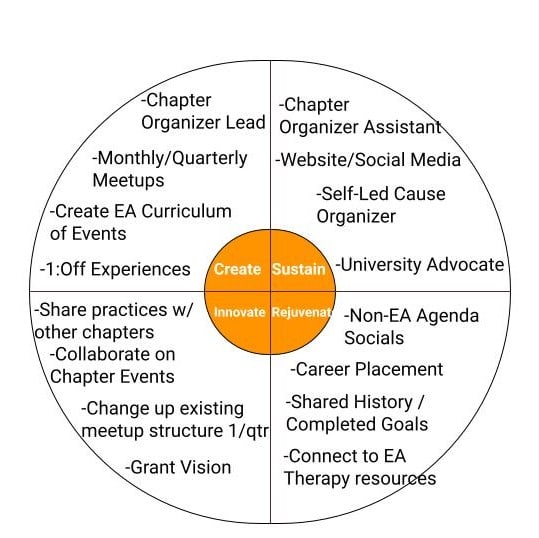
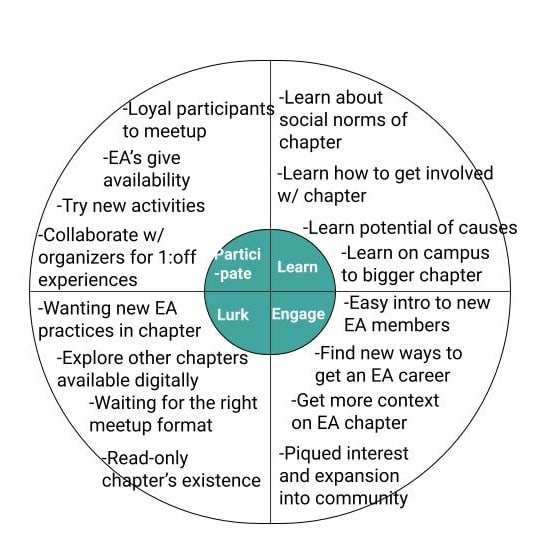
5.4.5 Null Case
If the EA local chapters are not properly managed and restructured, in one year, there will be a drop-off rate of at least 10% of chapters per year. In a few years, the chapters could amount to 300-400 groups with only 5% (15-20 groups) that are actually active. The cycle will continue as the resources, grants, and funding are wasted to sustain chapters that aren’t worth pursuing or are strategically placed to move. Many people will attend one EA chapter event and have no incentive to return as the organization is informidable. Additionally, the vanity of being a chapter organizer should not be the driving factor for building one for 6 months and then abandoning it when joining as a CEA employee or EA-aligned career.
In the following passages, these are the programs I have suggested EA are to pursue in the ideal outcome of EA as listed in Section 5.3. I have listed brief strategies that can get the momentum moving along and the EA team / community can put the CAM + CCM to work and apply the models if they are interested in pursuing these suggested outcomes.
5.5 Programs for Create / Participate
5.5.1 Cause Prioritization - Create / Planner
The Cause Areas are one of the most organized parts of EA. I do not agree with all of the causes or prioritization, but as an operational part of the community - it is more efficient than the other EA facts. There could be a more diverse range of cause areas but that would involve changing the core values of the movement and expanding outside of the EA morality framework. No further suggestions at this time.
5.5.2 EA Incubator - Create / Explorer
Diagnosis: There is no public-facing program that facilitates a breeding ground for new ideas within EA. The Forum offers the discussion board to consider new ideas and facilitate interaction but it is not a guarantee streamline into EA's organizational consciousness.
Proposal: Create a program that allows for young talent to create new cause areas, refine EA practices, and seed this talent into placement for cause ownership and grant execution.
Action Items: Take a survey for interest in an incubator program. Test a pilot with 5-8 contributors that are in high school or college.
Ideal Outcome: Long-term this would replenish new opportunities that are sourced within the EA organization and a continuous spring board for discovering internal innovation.
Null Case: If this is not created, it is not dire to the EA organization due to all of the other Creating activities.
5.5.3 EA Global Events - Create / Host
Diagnosis: EA Global Events are the top-tier participation for EA’s to strive to attend, speak and network at. Not only is it hyper-exclusive and gatekept for the only most coveted EA members, it is truly not open to the general public due to applications and surely inner-CEA politics. This creates an unnecessary culture of exclusion instead of identifying different opportunities to include potentially impressionable people that are open to the movement and looking to navigate their path.
Proposal: There needs to be a multi-tiered approach to EA Global through the stratified levels of participation. If applications are truly the delegating mechanism to sanction off EA status, the content and opportunities made available at the conference need to reflect them as such as well.
Action Items: Create different 3-5 different speaking tracks and workshops for the levels of desired participation by the EA community member personas. Create 3-5 different applications to properly assign which type of EA is assigned and ticketed the right tracks of association. Only certain talks are the inaugural and all hands on deck.
Ideal Outcome: EA Global should be a growing event each year. It could reach 2000-5000 attendees at each event easily if EA grows their movement and properly scale their most high profile event. The stratified tiers of engagement tracks will allow the right EAs to identify and find each other.
Null Case: EA Global will be an unnecessary event for the mature community members. It will be a hotbed playground for young ambitious non-EA/willing to convert EA’s instead of weaving together the mature EAs AND working with non/potential EAs and every person in between.
5.5.4 EA x City Events - Create / Experimenter
There are some similar points made about EA Global that can apply to EA x City events. There are no further suggestions I have for this program at this time.
5.6 Programs for Sustain / Learn
5.6.1 Altruists of the Year - Sustain / Advocate
Diagnosis: This program currently does not exist and there is no recognition program. Grant-making is not significant enough to be the only advocacy for EA . Egalitarian and merit-based recognition amongst the community is sparse at best due to its current structure of social currency.
Proposal: Create a program to spotlight the top contributing members of the EA community. The altruists that are awarded in the recognition program are given special opportunities within CEA / EA affiliated organizations to further their cause areas.
Action Items: Identify a 3-5 tier system of what EA’s Altruists of the Year look like. When they achieve this award, structure the incentives of what they get access to within the CEA organization. Highlight towards the end of 2022.
Ideal Outcome: Once this program is put in place, it is an appreciation mechanism that rewards people that are measured by their tangible outcomes, and not the politics of who won contests or was granted what for certain causes. Once the grants are given, where is the tangible results shared and further metrics to measure by and if the grant terms were actually? There should be tangible results in all parts of the community whether that's a program manager, chapter organizer, forum moderator etc. All roles are important in sustaining a community.
Null Case: Many of the long-term EAs have not found the right opportunity or been given the chance to shine in their own light. If there is only one or two metrics of "success" or "appreciation" for being a high-performing EA, there will be churn and less participation as the movement moves forwards.
5.6.2 Chapter Organization - Sustain / Organizer
See Section 5.4.
5.6.3 Forum Moderation - Sustain / Steward
Diagnosis: Upon first entering the website, there is only one concrete resource available for potentials EAs to go to and it is the Forum. Forums historically are targeted and utilized by a certain demographic - those that prioritize reading, logic, and no room for interpretation. There are no other resources to point to in 1) how to utilize the forum from a technical perspective 2) how to find other community engagement opportunities outside of reading and writing on a forum and 3) where are different tracks of becoming a successful EA.
Additionally, the Forum is too cluttered for a tangible grasp of what is going on in the organization. There are no bite-sized pieces of information to understand what is happening at any time in the organization, and the requirement to read at length at all times is a huge barrier to entry for others that. I have catalogued the amount of Forum posts for another glaring issue that is approaching the precipice of crisis.
| Year | Short-form Posts | Front Page Posts | Total Posts |
|---|---|---|---|
| 2013 | N/A | 75 | 75 |
| 2014 | N/A | 247 | 247 |
| 2015 | N/A | 553 | 553 |
| 2016 | N/A | 353 | 353 |
| 2017 | N/A | 366 | 366 |
| 2018 | N/A | 480 | 480 |
| 2019 | 81 | 1100 | 1181 |
| 2020 | 360 | 1696 | 2056 |
| 2021 | 418 | 2112 | 2530 |
| 2022 | 461 | 2714 | 3175 |
| TOTAL: | 1320 | 9696 | 11,016 |
This data was taken off the Forum from All Posts filtered by Yearly on 8/23/2022.
There was a huge spike of posts in 2020 - this could be lined up with EA history, but also the general zeitgeist of people seeking community digitally due to in-person engagements taken away from Covid. Over the past 2 years, the volume of forum posts have been growing at a 25% per year, and with 2022 still with 4 months left, it may expand to 30-35%.
This is exciting from the perspective that this data has proven the expansive phase that EA has just begun to expand their movement building ambitions. However, this creates a new problem of infohazards, information overload, and a culture of writing instead of doing.
Proposal: Identify the most ideal outcomes of in-person engagement to come from the Forum. This could include more cause contributors, future chapter organizers, etc. Create an analysis of content over the past 3 years and identify the ramp up points for content production. Reduce and templatize the cadence of official organization communications with the minimum viable information needed.
Action Items: Define and create higher filters for what is necessary to read and what is optional. Refine community moderator program to help the CEA team redelegate what is official communications and community-led communications. Decide what is a quantifiable and quality forum post to curate better reading. Give instructions on how to best utilize the Forum. Identify top engaged Forum posters and assign or delegate EA-specific opportunities to move them off the Forum.
Ideal Outcome: EA will have created a streamlined Forum experience. Power users of Forum are rewarded through EA opportunities if not already involved. Forum user-generated content can scale heavily without the burden on the existing Community Health Team and is delegated onto a trained Forum Moderator program. New EAs can easily access and identify which parts of the Forum are mandatory reading and which are optional and cause adjacent.
Null Case: If the Forum is left alone and is not anymore heavily moderated or adjusted for its increase in post and size volume, the Forum will become out of control and unmanageable to read and engage with for the average EA. This will deter the Forum as a reliable resource for EA to leverage in communication, collaboration, and accessibility of ideas.
5.6.4 Overall Platform Management - Sustain / Front-liners
Diagnosis: The true EA rabbit hole is the disorganization of its digital platforms. It is too cluttered with no way to leap frog across all of its digital spaces. There isn’t even a diagram to utilize to keep track of all activity across platforms. The existing platforms and websites are also moot as they do not have up-to-date information and are pretty useless in identifying the most recent news, making the Forum the only semi-reliable resource. EA is still vastly a digital movement which is why figuring out and delegating platform management should be in high priority to maximize the amount of traffic and funneling to utilize.
Proposal: Consolidate to 3 platforms max. EA needs to emphasize which platforms maximize their community goals and recruiting opportunities for their objectives.
Action Items: Create a diagram of all of the EA platforms and which one is for what objective, purpose, and drives movement-aligned goals. Create a visualization of where each pool of EAs community hang out and operate out of.
Ideal Outcome: Create a streamlined and cohesive experience for potential new EAs and existing EAs. They are able to quickly find the content and area that they need without the headache of cross-posting. They are able to identify and easily get in contact with the people and resources needed to actualize their goals.
Null Case: The EA platforms will get out of control if this is not standardized and consolidated. There are already the Forum, EA site, CEA site, EA Global site, EA Hub, FB Group, EA Gathertown, all not including all the chapters that have not been collapsed into one place. In one year, there will likely be 2-3 more platforms if there is no control such as the EA coworking, a Discord, etc. If this is not resolved within the new few years, most new EAs will be unable to navigate the increasing amount of resources available and will not be able to funnel into the CAM and CCM system since they are left at the Lurk stage - without even the full ability to Lurk because they’re in a trapped a fixed spot in the EA metaverse.
5.7 Programs for Rejuvenate / Addressing Engage
This is where EA was lacking the most as addressed in Section 5.3 These programs will help round out the militant style of EA ideology and create a better and well-rounded future of sustainable movement building.
5.7.1 Mentorship - Rejuvenate / Matchmaker
Diagnosis: The community is ripe for having a multi-tiered approach to assess and pluck community engagement through career development and training, EA progress, and maturity. There have been multiple requests for mentorship seeing as EA can span from under-graduate to senior level as it is lacking different levels of EA in career development and who has had EA careers or not.
The current booking of 1:1’s is far too small for the scale EA is currently at.
Proposal: Utilize a platform like Meetsy would be able to automate the introductions and still gives the community member autonomous nature for free reign of scheduling sessions, and organic dialogue with other consenting community members. The users would be able to self-navigate their mentorship experience and the facilitation is mostly agnostic to any individual work that any CEA team member would have to directly put effort into.
Action Items: Identify the different tiers to segment into the Meetsy matchmaking logic. Create incentives for connecting with X amount of EA community members per quarter for the most highly engaged participants of the program.
Ideal Outcome: Hundreds of EAs are able to engage and connect with other EAs based on the terms that they are looking for. Ideally if there were 1000 EA members looking to be mentored and they are all doing one 1:1 video call per month, that would be 12,000 new interpersonal connections made and weaved across the community - and each individual can gain 12 new connections within a year that may not have been previously accessible through EA Global and other events.
Null Case: If this program is not actualized, a few scenarios may happen. As the movement grows, predatory and non-official EA people and organizations will capture this opportunity and poach away talent and lost EAs. There could also be community-led mentorship that will quickly churn and die without the proper resources and buy-in to succeed in sustaining. Ideally this is CEA run so that the infrastructure and resources needed to facilitate are regulated by the organization and attended to.
5.7.2 Virtual Coworking - Sustain / Weaver
Diagnosis: Virtual coworking has been brought up numerous times in the Forum as an opportunity for virtual EAs to connect outside of virtual EA events. This has been a coordination effort that has been low on effectiveness and poor implementation.
Proposal: Create shifts in the programming by aligning topics and causes to attract EAs of several sectors. Suggest new EAs that have not attended a local chapter as an opportunity to engage with EA culture first before attending an IRL event that requires more buy-in.
Action Items: Make it a weekly occurrence. Create shifts for volunteers to sign up to facilitate coworking / office hours environment.
Ideal Outcome: If virtual coworking were to succeed, it would give the opening and opportunities for hard-to-reach or EAs that are unable to travel or live in larger EA Hub cities to circumvent the community and make the necessary connections to continue participation and contribute towards the community. Ideally there are 2 coworking days a week that have 4-6 hour shifts per time zone. This creates a 24 hour cycle for EAs across the globe to have access to the same experience and connect with other virtual EAs.
Null Case: If virtual coworking for EA did not exist, it is honestly not a make or break moment for the community. However, if implemented incorrectly, it can be more detrimental than its positive impacts. Poor experiences in a virtual environment are the least ideal outcome of any hybrid community. Poor experiences in-person incentivize hybrid community consumers to still participate digitally. However, poor experiences digitally allow for digital community consumers to never digitally engage, and likely never participate in-person.
5.7.3 Mature EAs - Sustain / Storyteller
Diagnosis: Currently, there is no segmentation by maturity for EA community members. In the current demographics of the communities, there are clear categories of duration of involvement within the movement, despite the intermixing of them all. Many have left the movement, but many still trudge forward despite delays or their contributions non-prioritized. Coming back to the CCM in 2.9, if the innovation is lacking and/or has disappeared, the members that Participate will detract on the consumption ladder and return back to Lurk.
Any community will face continual onboarding, where you must replace and start the CCM all over again by starting off the new members to Lurk all the way to Participate. The issue with EA is that in its current state, it does not serve new members, or the mature / old members of the community, effectively.
The churn cycle of the community has the leakiest of buckets at the do you donate or do you not donate crossroads. Without actionable items aside from showing up in-person to meetups, how could one progress beyond that? What are the tracks to success and best practices of what it means to be a productive, useful, and agentic EA community member?
Proposal: Re-engage previously long-committed EAs and get their feedback on how to make them return to the community. Identify common tracks that mature EAs take when they leave the community and strategize new opportunities to keep them engaged for the long-haul.
Action Items: Create timeline structure of what long-committed EAs look like. This can span 5, 10, 20 years and beyond. Create a community journey of where they should be at each point in the journey depending on their contributions and their length of duration of self identifying and becoming part of EA.
Ideal Outcome: Previous EAs that have left the movement will return to EA in hopes their causes and good they want to do will be prioritized. The multitude of paths are crafted for long-committed EAs to stay engaged and re-engage in a way the movement previously was not able to provide.
Null Case: If the maturity of the community is not addressed and does not fix the leaky bucket of churn, the EA movement will simply never last. EA’s goal is to carry forth for years, decades, and even more beyond that. That would mean growing, maturing, and attending to the contributors that created the movement at varying degrees of the movement. There is no inter-generational EA, and if there is going to be such a concept in the future, the mature long-standing EAs must be incentivized to stick around and continue to contribute. Otherwise there is no future for longtermism.
5.7.4 Community Health Team - Rejuvenate / Caregiver
Diagnosis: Understaffed for the actual work but the implementation is weak and the work put in has not been displayed in the metrics the community produces. The CHT has also been tasked with the management of the community but its proper place is actually in rejuvenation as their roles have not defined or put in enough work to be building and sustaining the movement productively.
Proposal: CHT should read this manifesto :).
Action Items: Hire a community consultant. Read up on traditional community management forums, resources, communities to level up community management education. Set objectives, KPIs, and tangible goals to work towards.
Ideal Outcome: A more robust CHT . Ideally there should be a Community Events Team (Create), Community Education Team (Sustain), Community Health Team (Rejuvenate), and Community Incubator Team (Innovate). Maybe some of these roles are filled by other departments within CEA but it is not clear through the practices and outcomes of the EA organization.
Null Case: If the Community Health Team does not improve its operations, execution, and growing the team, the future of EA’s community is at severe risk. The community managers are often what move the community forward, not the upper management.
5.8 Programs for Innovate / Addressing Lurk
5.8.1 EA Literature - Innovate / Visionary
Diagnosis: They are too pretentious and don’t have enough accessibility for people across the globe.
Proposal: Creating 3-4 different comprehension levels for EA to give access to a wider variety of community consumption. They should span an average 5th grade reading level, average high school reading level, average college level reading, and a professionally-coded EA for training and Corporate Responsibility education. Then, utilize a Learning Management Software to create an E-learning experience. This would be a tool for adoption and scaling. The books are great for the in-depth highly educated person that would participate in EA. However, if there is to be a big-tent movement, there needs to be more than just university-educated participants to make that a reality.
There also is a language barrier which holds back different countries and cultures from accessing EA's philosophy. This is not difficult through all of the digital language translating services, it would take a phenomenal editor in each language to be able to hammer out the tone and true definitions of EA’s core beliefs.
Action Items: Identify top 5 countries/languages that have EA chapters and significance and prioritize these translations first. The education modules that are created will also be translated.
Ideal Outcome: EA Literature can be accessed at different ages and backgrounds and from different cultures. This will transgress the movement past the demographic of highly educated Western individuals adding diversity to the movement.
Null Case: This will stay only in English-speaking countries, and there will be little to no pushback from different cultures on how to integrate EA into their existing society and culture. Not all countries have a capitalistic background to sustain and support EA’s practices. If EA as a movement were to prevail globally, they will have to overcome the non-diverse and ideological bubble they live in.
5.8.2 Career Placement - Innovate / Explorer
Diagnosis: A large part of the EA movement is the book 80,000 hours which dictates the opportunity to choose the better part of your life to dedicate to a career towards doing good. However in EA’s current talent placement and job board, there is not enough transparency in the process, exhaustive processes to participate
Proposal: Create career mapping journeys for different stages of careers. Create alternate career mapping journeys for university students.
Action Items: Create a sequence of logic of how much on the EA scale does a potential EA want an EA aligned career? This is the make or break it moment for new EAs where they can decide how they want to craft the next 5, 10, 20 years of their life.
Ideal Outcome: Have a numeric and trackable amount of people that placed through EA-aligned organizations.
Null Case: If there is no progress in career placement for EAs, there will continue to be a break-off point for a lot of potential community members and they will drop off and churn. As much as EA is supposedly about morality, it is a hotbed of academics and ambitious professionals that are looking to intersect their desire for passion and purpose with their tangible day-to-day work. If the EA community cannot provide those opportunities, as much as they have attracted the readers of 80,000 hours for a short duration of time, they will have long-term failed in achieving proper career placement and converting these potential EAs into fulfilling EA’s desired prophecy.
5.8.3 Leading Women of EA - Innovate / Innovator
Diagnosis: It is honestly shocking how abysmally small there are pro-women anything I’ve seen in the EA community. One of the most disappointing days of writing this thesis was the day of and after Roe vs. Wade overturned, and continually to this day, there was no mention of it anywhere in EA writings. This does not even cover the lack of any intersectionality of diversity in the community - the movement still has not been able to overcome the hurdle of attracting the opposite sex.
Proposal: I am personally am not of the belief of championing employee resource groups. What I think is ideal in making change is promoting and elevating exemplary examples of existing and soon-to-be-kick-ass leadership.
Action Items: Identify and calculate what is the actual gender ratio that is within the EA community. Identify if there is any segmentation within the gender ratio in the community and diagnose the problems.
Ideal Outcome: Promoting women into leadership in all factions of the CEA organization - and not through gendered roles. Having diverse individuals and ideologies that are intersected throughout various parts of the EA organization.
Null Case: If there is no progress for women in the EA space, well, that’s honestly pathetic. It should seem like a given, and yet execution has failed. It isn’t the direct recruitment of women that is what is lacking in EA, it is setting the parameters and potential for what EA can contribute towards causes, valuing diverse perspectives.
5.8.4 Crypto Pioneers - Innovate / Explorer
Diagnosis: What intrigues me most about EA’s funding is that much of its funding comes from recent crypto billionaire, Sam Bankman-Fried. Currently EA accepts donations via crypto which is probably a side effect of the high frequency traders making cash on the side in the most recent bull market. However, where does EA stand in terms of crypto existentialism? Or what crypto culture represents?
Proposal: Create an EA approved stance on crypto. Craft a strategy surrounding crypto/blockchain aligned causes and opportunities in existing cause areas and funding opportunities.
Action Items: If EA's take is in favor of crypto, create a targeting and alignment strategy to attract more funding from crypto whales. Identify developing technology that enhances certain cause areas.
Ideal Outcome: EA has a strong and streamlined strategy surrounding new money and infiltrates the industry while it is still early.
Null Case: If EA does not pursue crypto culture and figures as a part of its fundraising potential, it will lack innovation in ten, twenty, thirty years down the line. In the next 2-3 years, it would be a missed opportunity for not only fundraising but for new cost-effective opportunities within charity that blockchain and crypto unlock.
5.9 Exercises for the EA Community
If you identify as an EA/EA adjacent, here are some exercises to better enhance your contributions and participation in the EA community. This is best used for reflection and to be utilized with the exercises listed in Section 3.9.
5.9.1 If you are part of the CEA organization
- What part of EA has not been actualized that you could bring forth in your domain?
- What part of EA’s community could use more expansion?
- Where in the CEA organization needs to improve?
- How does the CEA org fit into the CAM and CCM?
- Where is the CEA lacking in the CAM and CCM?
5.9.2 If you are an EA chapter organizer
- Where does your chapter currently lie?
- What are the metrics associated with the current chapter you have been building?
- Where does your chapter fit into the CAM and CCM?
- Where in your chapter is missing certain quadrants of the CAM and CCM?
- Where would you like for your chapter to be? What metrics would define a successful chapter to you?
- What are the barriers to get your chapter to that point?
5.9.3 If you are an active EA cause area
- Where does your cause area currently lie?
- What are the metrics associated with the cause area that you have been building?
- Where does the cause area lie in both the CAM and CCM?
- Where does the cause area lack in both the CAM and CCM?
- Where would you like for the cause area to be? What metrics would define a successful cause area to you?
- What are the barriers to get your chapter to that point?
5.9.4 If you are an active EA chapter member
- How often are you actively participating in the chapter?
- Where do you lie in the CCM? Which consuming action do you primarily take in?
- Are you willing to move up the consumption ladder or down?
- Where could your chapter improve that hasn’t already?
- Do you want to be part of the CAM for your local chapter?
- What would it take for you to be part of the CAM for your local chapter?
5.9.5 If you are someone that wants to participate in EA but does not know how to
- What motivates you to want to participate in EA?
- What doesn’t already exist within EA that you would like to see?
- Where do you lie in the CCM? Which consuming action do you primarily take in?
- Where in the EA CAM do you think you could contribute?
- Reference exercises in Section 3 and complete this about EA.
5.9.6 If you are an EA lurker
- Why are you so inclined to lurk?
- Do you want to remain a lurker?
- What would incentive you to not be a lurker?
- Where in the consumption cycles would you like to be in the EA community? Lurk, Engage, Learn, or Participate?
- If you were to graduate from being the CCM
- Would you want to be a contributor in the CAM? What does being part of the CAM to EA mean to you?
Section 6 - Conclusion
6.1 EA is not an effective or operational community
Time and time again I have proven that EA does not fit into the CAM + CCM and cannot achieve long-term sustainability. It is a muddled and haphazard organization that has a long way to go to prove to be operationally excellent and efficient. My community-building models were not necessary for even an average person to see this, but this dissertation has detailed all of the points EA needs to restrategize, reconfigure and redefine what the EA community core of community actions and consumptions are to move forward.
6.2 If EA does not heed my advice
They will fail as a “community” and will have such high rates of churn that even in years time they will not surpass the same ratio threshold as today. Let’s say that there are 10,000 people in the EA community today with an 8% churn rate. This would mean that each year you would be losing 800 people. Even if there was a 10% growth rate each year, the movement nets 200 people/year. Where and how is EA equipped to address churn, replacing the churn, and maintaining the expectations of long-term EAs?
This ratio is an exaggeration and needs to be properly calculated within the CEA team, but if there is something that EA takes away from this manifesto is that if they do not calculate their movement churn and growth potential, the movement will never grow past its current state today. Maybe there will be more followers of the literature, more cause areas expanded into, but the systems that have currently set up the movement will continue to fail and the churn rate will expand beyond current comprehension.
If EA chooses to not implement any of this tangible advice, it will be on a rapid churn cycle and turn into a new movement less dense and less opaque every 2-3 years as already proven with the past 10 years of the movement. The growth achieved will also lessen because for all the newly onboarded EAs. The experienced and seasoned EAs will leave without the innovation necessary to keep them participating and contributing towards the movement. EA seems to be having the most action-oriented impact from university students who give the free time, passion for change, and naiveness of ignorance it takes to achieve it. However, EA does not currently have the grit, foundation, or substance to achieve its longtermist goals.
6.3 Am I an EA?
After spending the entire summer studying, analyzing, and digesting what EA was and has become, I will clearly pronounce that I am NOT an EA, in the terms that the movement defines what an EA should be. I do not believe in cost-effectiveness ratios of people’s talent, utilitarianism, and all the jargon and politics associated with the movement. Maybe it’s naivety, maybe it’s my personality, and maybe it’s the fact I’ve built communities from scratch up to 1.5 million people and understand people more than I could ever understand numbers. EA is aspirational to a certain type of person that needs to replace their lack of guiding moral compass with a predestined philosophy, instead of what most people should do - craft their own. The worst part is that many people in the EA community are brilliant - just grossly misguided.
Would I say that I am a non-capitalized effective altruist? Yes. There is salient justice in identifying the best ways to do good in this world and to pursue it. Until EA adjusts and has a more diverse definition of what EAs can be within their organization - I can never fully participate. I want to make tangible change in this world, not just be at the mercy of pedigreed elites that certainly do not live and breathe the values they preach.
6.4 Where do we go from this manifesto?
I would love any feedback on the manifesto in the comments - the good, the bad, the unexpected.
I will be expanding my community philosophy, theory, and education into a book to help community builders, managers, and solvers across the globe to equip them with the tools necessary to create their best community they envisioned. I am also building a digital platform for hybrid social infrastructure that addresses and resolves many of the ideas brought up in the philosophy part of my essay.
If you are interested in serious conversations about improving the future of communities, more advanced social technology for a brighter social future, and applying the current CAM + CCM (especially from a graphics/visualization perspective), please contact me.
Most of all, if you’ve made it this far, please think about the communities you’re a part of. Do they fit these models? How could they change to better fit the CAM and CCM? How do you contribute and where do you want to be in part of the 4 community actions and consumptions? How do you reprioritize your actions to change your identity in these communities?
This manifesto is my Innovate action towards the Effective Altruism community. I have Explored the options available, Innovated existing practices for improved output, and laid out the Vision for the future of the movement in hopes to Disrupt the community enough to begin a more proactive chapter of community expansion and productive movement development.
Conclusively, I have chosen my contributing community action. What will yours be?
With the most sincere defiance,
ATW

HI there, lots of interesting stuff here! not claiming to have read the whole thing but a few things that come to mind
Who's 'we' in this that constitutes the 'our'?
The introductory paragraphs of Section 2 - I'm afraid I don't know what/who you're talking about 😃 That's not to say you aren't addressing a real phenomenon, it's just that I lack the context to understand what issues you're addressing
You use a lot of passive voice, e.g. "Agency is what should be taught and internalized throughout any education" -- hard for me to slog through these sentences as a reader
OK will read more and comment more later I hope!
Hi Seth, thanks for your comment! I ran out of time while I was writing and didn't properly context switch for Sections 1-3. This was more in a vague societal sense and not through the EA lens. I am writing a book and Sections 1-3 were taken from that. Great feedback though that I should narrow the context.
Hope you have more feedback!
Thanks for this. I read or skimmed about 60-70% I think, and found about 20% pretty valuable. I like your Community Action and Community Consumption models and some of the graphics describing them.
A couple of questions:
Hello Sphor, thanks for your comment! I intentionally made this a long-form post. I had already had around 10-15 more pages that I had cut out. If I had made it just a 10-20 minute read, it would have been just as generic, non-technical, and non-actionable as the rest of the "community improvement" discourse that surrounds EA. It pops up everyday on this forum, and these generic points can all be referenced as a point I've tackled in this series of essays.
As for intended audience, I think that is addressed in Section 5.9 . I think each community person within EA should read this and take a step back to see if they've realized what they've built and how they're willing to contribute moving forward. The most impactful read would be someone within CEA that wants to take actions in what I've written. If not, I do believe many of my predictions and impending issues they will face will come true.
The only sections that are not EA specific are Sections 1-3. They will be expanded as community education that I'm developing and is what I'm taking with me from this contest. If EA wants to fix these things, they are more than welcome to, but it is not my job or duty. :)
Hi, thanks for the reply. To clarify I was sincerely curious to hear your responses and wasn't trying to push you to put in even more work than you've already done. I agree both that there are serious issues with the EA community and that it's up to the EA community to fix its issues.
I'm curious why you think this; it doesn't seem true to me. You have plenty of concrete models and points and go into far more depth than most discourse. I could be wrong but I feel you could create a powerful shortish essay or presentation that focuses on your key points and models. I think this could make your material much more accessible and might help with your book as well. To be clear, I mean this as general feedback, not specific to EA, and I'm also not suggesting you do actually this, just raising it as a possibility.
Got it! Yes - it's on my roadmap for what I'm building to create more accessible content surrounding my ideas and at different reading comprehension levels (similar to what I suggested in Section 5.8.1) :).
I literally wrote this entire thing in 20 days so I was cramming it all out. The revisions will come soon and I will share the polished models / website / workshops / etc that's shareable across communities - not just the EA one. My north star is making community building education accessible and implementable, this submission was just an exercise for me to test it out.
The reason why I think the discourse is generic is that every single EA community problem addressed boils down to how faulty the community was originally built. As listed in Section 5.1, the organization is based off of the EA models provided to community builders and I describe at length why their models should be debunked and further give instruction in how to mediate and change this. I provided the tools, action items, and education necessary to level up and the community discourse is cyclical and circular. They will keep running into the same problems until they change what I've listed in the essays.
I had considered making a list and referencing the top 50 community building/discourse posts and allocating them in each appropriate part of my submission to show how they need and can be resolved by my suggestions, but I ran out of time. I could of course comment on every single post and reference which part of my submission where this is covered but alas - until it is wanted - the point is moot.
Sounds great. I look forward to reading your future work :)
Thank you for the effort you've put into this.
"adjust the university chapters and transform them into a student ambassador program to work alongside long-term community organizers."
I feel like there are some good ideas in here that most people won't find because they're buried deep within the text. I'd also like to see you 1) elaborate on your action proposals further 2) rank them in terms of potential impact, 3) discuss them in light of existing opportunities and data/research. I think that might spark more discussion.
For example, for virtual coworking and exploration there is a more casual EA gathertown as well as CEA's standardized virtual programs. I'm wondering how your proposals differ from them or could be combined with them or how they could be improved in your view. It seems like you say there's too much centralization but then also not enough to standardize all the platforms.
Hi Peter, thanks for your comment! The purpose of this manifesto is that EA's core team needs to do the work to fix the community. The community can't do it themselves. And, the community needs to recognize its shortcoming and how to work together to mediate these issues.....if they even believe these are issues. If I had won the contest, maybe I would be inclined to further elaborate and prioritize, but I didn't, and unless I'm hired as a community consultant, I won't be doing such unpaid labor. :)
Ideally my proposals should be combined and tested to see which ones work best. Many of my proposals don't really exist or have any long-term foresight as to facing upcoming challenges that I've addressed. If I were to add anything to this I would have made a point that there is an inaccurate centralization, and the centralization needs to be recalibrated.
Oh I can see what you mean. This post probably already took so many hours to make. Thanks for your response.
I think another part is that there definitely seems to be some variety of opinion on how targeted EA should be vs broad to maximize impact. I think I lean more towards broader, since 100 people doing their best is probably better than 10, even if the 10 are in 5x more high impact roles/situations. I have some other half baked thoughts probably but I should take some time to think them through.